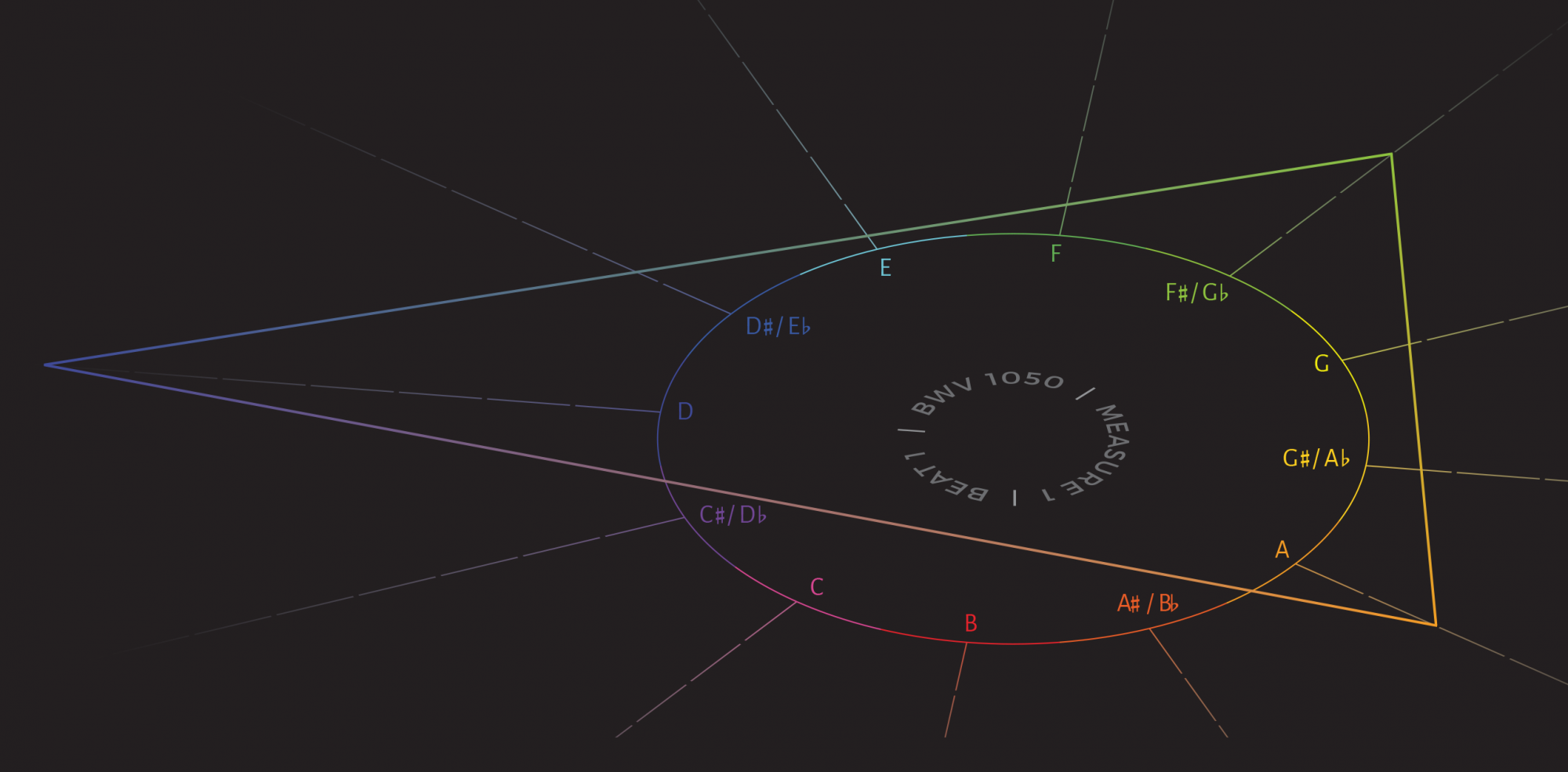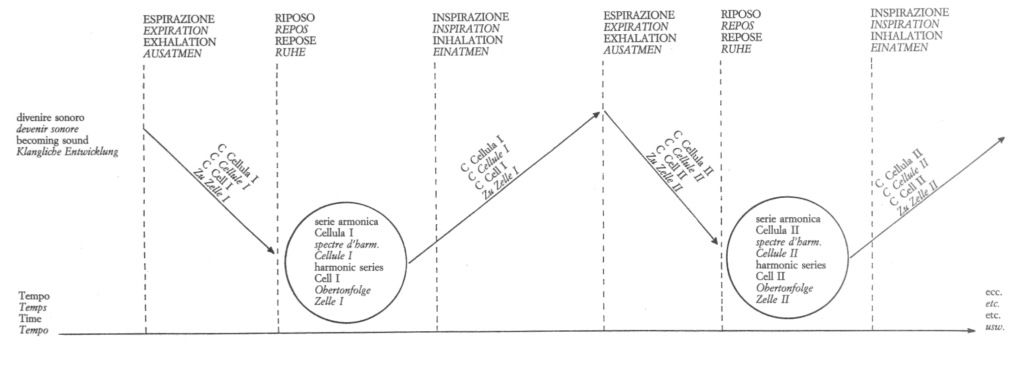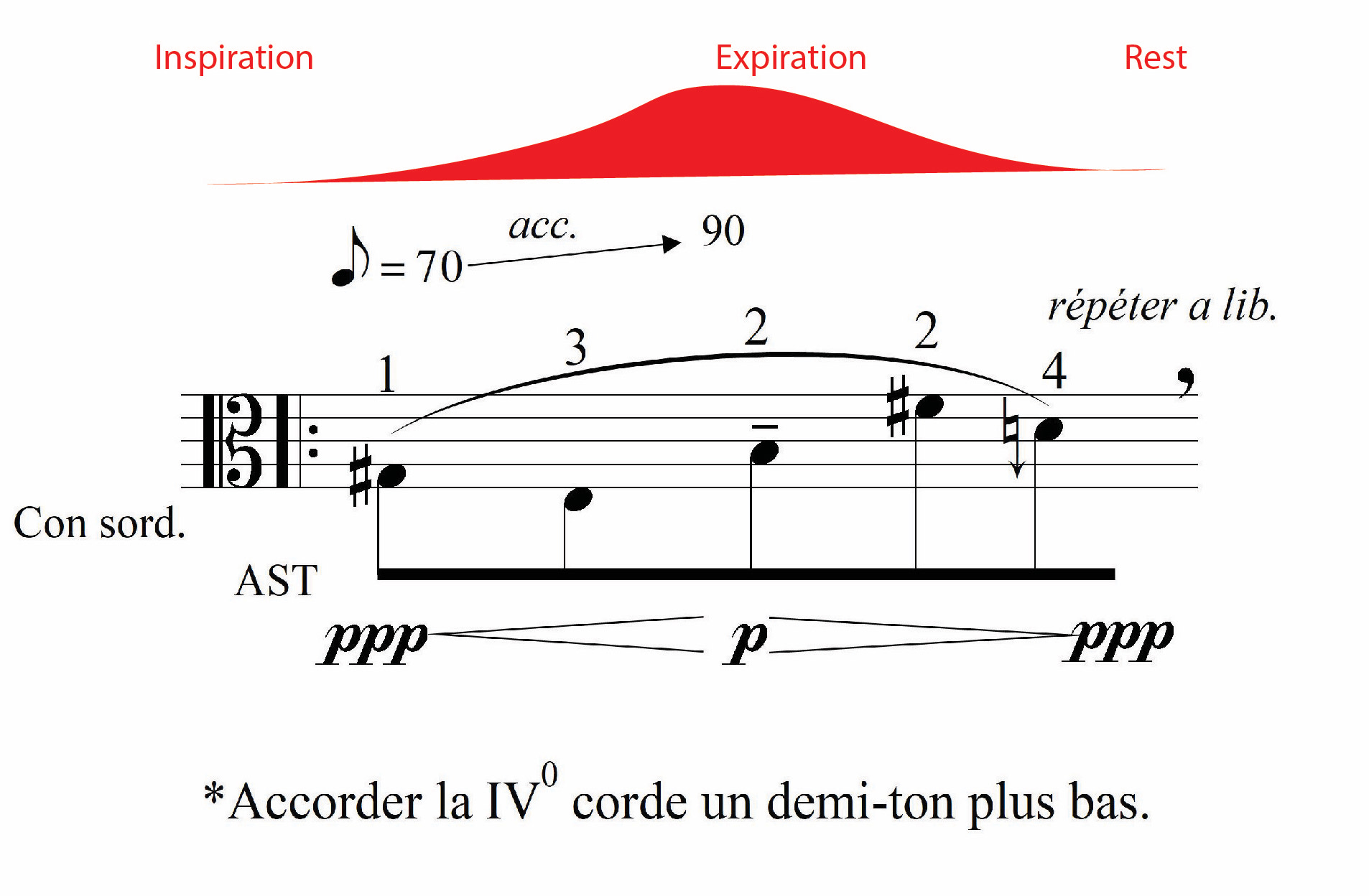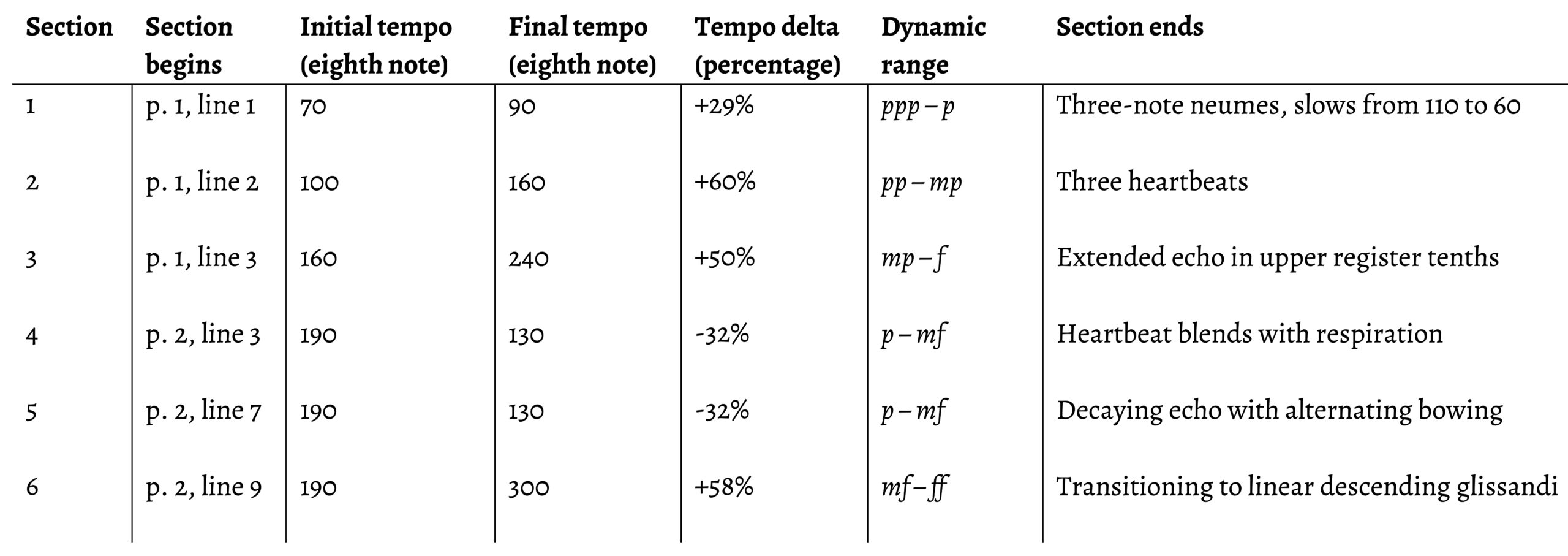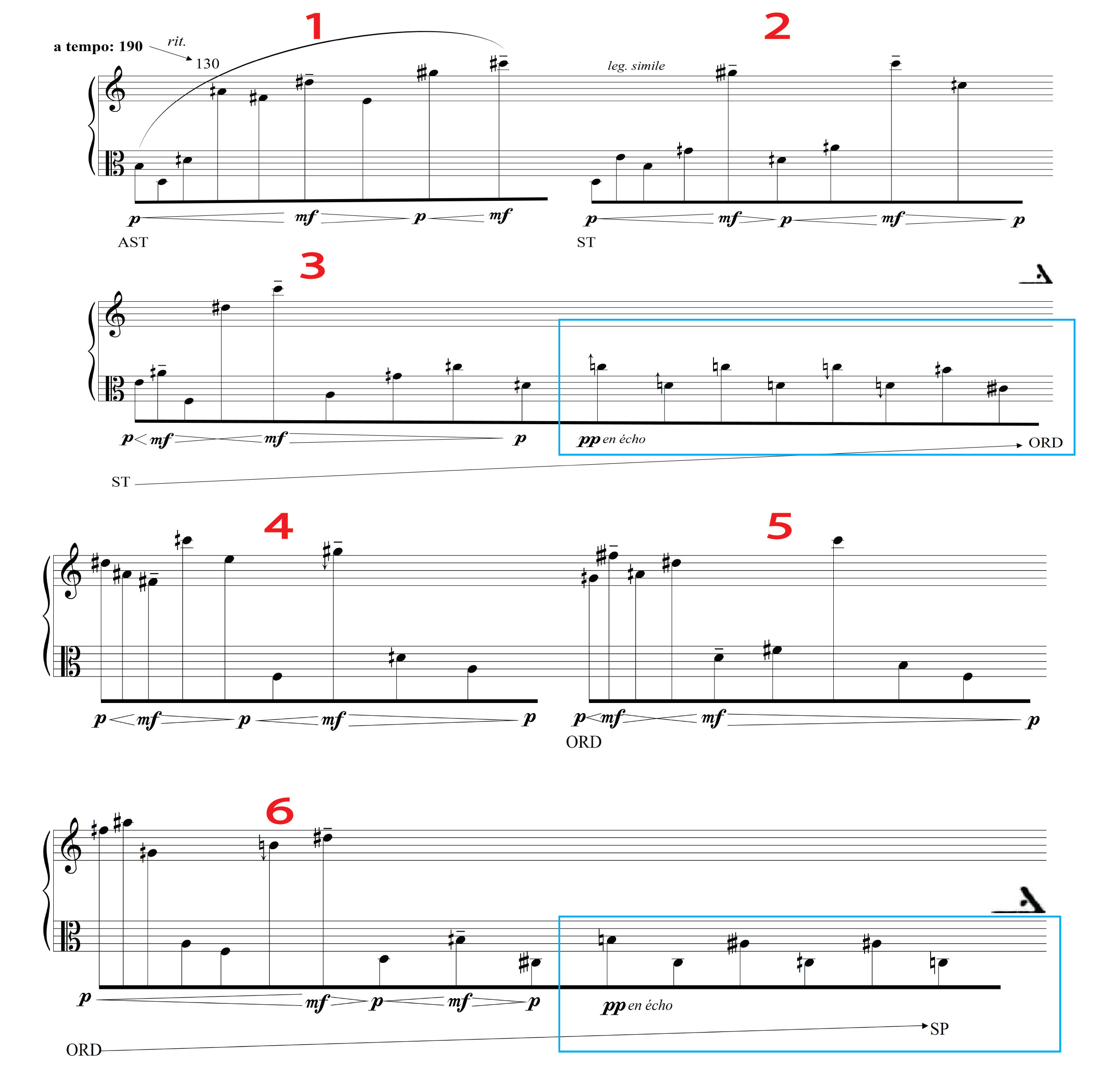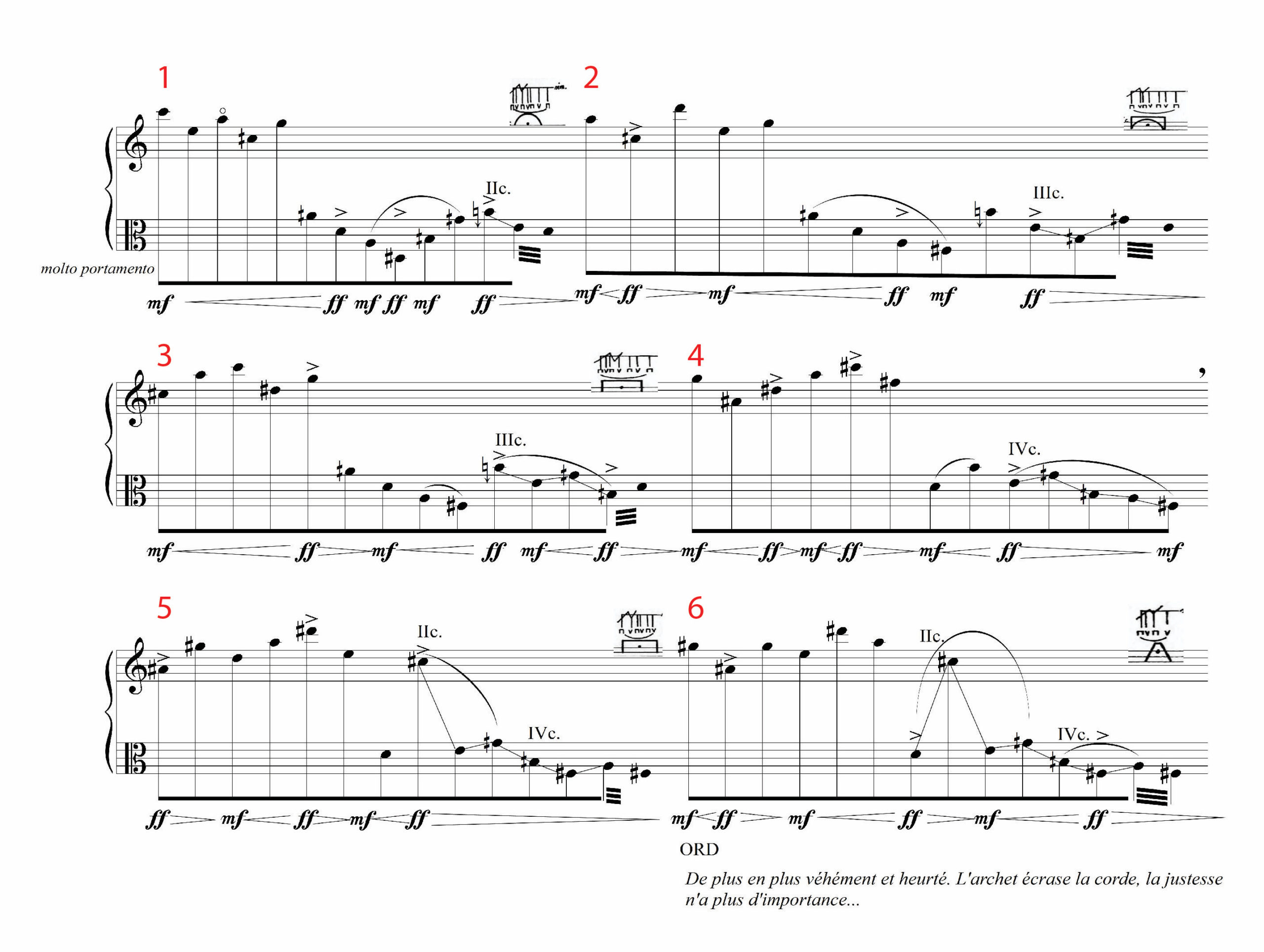Joseph R. Jakubowski
Abstract
This article explores intersections of embodied cognition and form in Gérard Grisey’s Prologue pour alto seul (1976). Drawing on work in mimetic imagery, gestural cognition, and body-based conceptualization, I trace Prologue’s seemingly abstract processes of variation, opposition, and tension to the performer’s actions and an embodied listener’s responses to those actions. My analysis demonstrates how Prologue relies on the body as a medium and metaphor for its structuring, from Grisey’s bodily metaphors for its motives to listeners’ responses to its boisterous and noisy climactic section. By concentrating on performance and embodiment concerns, I aim in my analysis to bring out the implicit role of bodies and materials in spectral theory and discourse more broadly. In conclusion, I reconsider the commonly held notion that spectral music is “about” sound in light of the close associations of sound with movement and action identified by embodied cognition.
View PDF
Return to Volume 34
Keywords and phrases: Embodied cognition; gesture; conceptual modeling; form; spectral music; Gérard Grisey
Suggested CitationIntroduction
Recent work in music and embodied cognition has convincingly shown the links between bodily understandings and musical experiences. Perceptions of musical movement relate to listeners’ knowledge of movement—whether that movement is observed in performance (Mead 1999), related to natural “dynamic processes” (Zbikowski 2017), or filtered through proprioceptive, haptic, or kinesthetic experiences in their own bodies (Acitores 2011; Peters 2012; Kozak 2015). Listening to music entails representations of motion alongside patterns of sound (Godøy 2018); these representations contribute to judgements about music’s structure, time, and affect (Cox 2011; Kozak 2020). More broadly, important analytical concepts such as tension and release can be traced to body-based image schemata (Saslaw 1996; Brower 1997/98; Lakoff and Johnson 1999), or else related to basic life functions, such as breathing and abdominal contractions (Cox 2016).
The embodied perspective is especially important (though under-explored) in the case of avant-garde music, whose expanded palette of sounds and forms invites listeners and analysts into a direct engagement with performance and movement.1Consider Gérard Grisey’s Prologue pour alto seul (1976; hereafter, Prologue), a piece of early spectral music for solo viola. Prologue consists of a gradually developing process, wherein an initially soft five-tone melodic motive is repeated and transformed into a series of complex and noisy glissandi played with extreme bow pressure. Past analyses of Prologue have expounded its construction from the combination of discrete neumes (Baillet 2000), traced the historical evolution of the piece through successive versions incorporating acoustic and electroacoustic resonators (Féron n.d.), and related its repetition-and-variation form to Grisey’s ideas about temporality (Hennessy 2009). Missing from these analyses is the human body. Grisey, in fact, conceived of this piece bodily, labeling its two main motives a “respiration” and a “heartbeat.”2 Moreover, Prologue’s phrases can be clearly classified as “gestural”: they foreground “analog” aspects of musical structure such as non-discrete pitch continua (through the use of microtones), fluid tempi, and swelling dynamic contours (“hairpin” shapes).3
There is, I would argue, a compelling way of listening to Prologue that focuses less on its construction and more on the immediacy of its feeling. Such a hearing depends on engaging with the bodily movements of the violist, out of which the form springs. This engagement will be rooted in the embodied listener, whose familiarity with the gestural-material roots of sound production and expression—to varying degrees of specificity—shapes what they hear and feel in the form.4 The piece offers a visceral experience on several levels: the variation of the motive relates to human movement patterns and intentions; an opposition between motives outlines a form with a kinesthetic contrast between modes of sound production; and formal tension is expressed through increasing timbral noise, deriving from bodily tension in the production of said noise.
This article re-situates Prologue between performance and perception. My analysis demonstrates how its process-driven form relies on the body as a medium and metaphor for its structuring. I elaborate on the three levels of experience introduced above—variation, opposition, and tension— in three successive takes on the form. In doing so, I unpack these seemingly abstract formal concepts in light of theories of embodiment, from gestural cognition (Godøy 2010) to Mimetic Motor Imagery (Cox 2016) and body-based conceptual modeling (Brower 1997/98; Mead 1999; Zbikowski 2017), among others. Taken together, the analyses elucidate how the specific actions required of a performer, the changes to those actions over time, and their interaction with the materiality of the viola relate to aural impressions and in-time conceptualizations of formal structure and development. More broadly, by concentrating on performance and embodiment in a close reading of the piece, I aim to bring out the implicit role of bodies and materials in spectral theory and discourse. I return to this last claim in the conclusion, where I reconsider the commonly held notion that spectral music is “about” sound by contextualizing existing interpretations of Prologue (and theories of Grisey’s music) in light of an embodied framework.
1. Respirations and Heartbeats: Embodied Metaphors in Prologue
Prologue is the opening movement of Grisey’s six-piece orchestral cycle, Les espaces acoustiques (1974–85).5 However, it was composed after the two movements that follow it, Périodes (1974) and Partiels (1975). Prologue builds on elements of Périodes, notably pitch and harmonic material—both are based on an E1 harmonic spectrum. Prologue also inherits a set of bodily metaphors for form from Périodes, centered on an essential life process: breathing. Example 1 reproduces the formal diagram included in the score for Périodes. Alternating sections act like inspirations and expirations, denoting generic increases and decreases in tension, respectively. Larger breathing cycles (each pair of inspiration and expiration) are delineated by moments of repose, expressed through sustained harmonies at very low volumes and an almost complete cessation of movement. Grisey generates a dramatic work by analogizing his cyclical developing form with a basic bodily process. The tension and relaxation inherent to everyday breathing, as well as breathing’s ability to pace and measure the flow of experienced time, inform the piece’s conceptual structure.
Where inspiration and expiration describe extended sections in Périodes, in Prologue the breath serves as a more local metaphor for the dynamic shape of a single melodic motive, united in the single shape of a “respiration” (see Example 2). Another motive, based on a similarly life-sustaining and time-marking bodily process, a “heartbeat,” inculcates a different type of time. This motive mimics the heart’s beating rhythm: played on a single pitch, its short-long patterns emphasize rhythm and immediately call to mind a heartbeat. Finally, the static repose sections of Périodes become moments of literal rest in Prologue through silences between statements of the respiration and the heartbeat, which provide space for the phrases to “breathe” while more clearly delineating segments and developmental phases.6
Now of course, one could not maintain life with this pace of breathing, and if our hearts beat only between breaths (and sometimes not for minutes at a time), we would not be long for this world. Moreover, we could hardly “breathe” along with the respiration motive beyond the first few phrases, which becomes so protracted and erratic just minutes into the piece that we would likely hyperventilate.7 To be sure, Prologue is not a literal, one-to-one imitation of a body’s life-sustaining processes. Nevertheless, Grisey’s metaphors transcend mere resemblances. By using these metaphors, he implicitly draws on his own embodied experiences of breathing, of feeling his heartbeat, of easing into repose between movements. These quotidian experiences then inform his conception of Prologue’s motives and formal development.8 Further, these metaphors readily activate bodily concepts for audiences, whether they have explicit knowledge about them (from reading the program notes) or merely implicit knowledge (the motives clearly “sound like” their bodily correlates). The gentle viola phrase resonates with the tensing-and-releasing shape of a breath that we experience thousands of times a day—not to mention the pervasive historical comparison of musical phrases to the breath. Finally, the bodily character of Grisey’s metaphors beget larger metaphorical associations with life processes. The piece may seem to have a life of its own: as it breathes and pulses, it also grows and evolves into something new.9
Grisey’s bodily metaphors in conceiving, composing, and describing the piece are an instance of embodied cognition par excellence. Breath and heartbeat animate what could have been a stoic expression of the E1 harmonic spectrum into a compelling composition. More levels of bodily meaning accrue from the performer, whose body moves to create not just sounds but motives, shapes, relationships, and affects.10 All this embodied meaning culminates in the form-focused listener, who recognizes metaphorical and literal movement in the sounds they hear in their quest to understand the form and interpret their affective responses to it.11
The embodied aspects of Prologue’s form may not be immediately evident to a listener, since embodiment influences our cognition at mostly a preconceptual, non-conscious level (Cox 2016).12 Consequently, one goal of the present analysis is to unpack how generic formal concepts (e.g. tension) in the piece reflect bodily engagements and assumptions. In the process, I also draw the reader’s attention to how bodily movement informs what there is to hear in the piece and how they may themselves hear the form. Foregrounding embodiment and performance can enrich subsequent hearings in new and profound ways as listeners become more attentive to how they engage with the music and how they might imaginatively “move” along with it.
2. Analyzing Prologue: Three Formal Concepts from the Body
My analysis highlights the main portion of Prologue: a twelve-minute process of increasing complexity and growing timbral noise leading to a climactic peak. In the caption for each example, I refer to the excerpt’s location within the published score by page and line number, abbreviated as page : line (e.g., 3:2). However, the location of a passage in the score is an imperfect measure of when a passage occurs. Prologue’s tempi and timings are fluid (every phrase accelerates or decelerates smoothly), the notation is spatialized (the distance between notes correlates to inter-onset interval), and there are no conventional measures or meters. To give a better sense of temporal proportion, I also list timestamps in the example captions based on the commercial recording by Garth Knox (Knox et al., 2005), from which I also draw the included audio examples.
There are three main elements of Prologue’s processual form. The first is the continuous variation of the respiration over time. Despite significant parametric differences between phrases, the form comes across as a series of variations on a few persistent motives. I connect this sense of variation to aspects of gestural cognition, particularly the tendency to perceive motion as action trajectories intentionally oriented toward important goal points. The second element is an opposition between respiration and heartbeat. This opposition stems from the motives’ differing modes of production and extends to formal function, with the heartbeat principally serving as a divider between larger sections of respiratory variations. But in two significant passages the two motives blend together, creating heartbeat-like melodies that blur distinctions and functions. The third element is an increase in tension over time. The increasing tension points toward the climactic passage, where peak tension is expressed by loud, scratchy glissandi. I trace the growing tension to the progressive transition from ordinario playing to extended techniques, arguing that Prologue’s increasingly tense sounds reflect the underlying tension of the violist’s muscular contractions and the viola’s strings’ tautness under extreme bow pressure. Analysis of the climactic passage and its aftermath extends the notion of tension beyond sheer sonic impact and ties it additionally to bodily tension. These passages show, in direct succession, how tension can be heard in both loud, energetic and soft, static passages.
3. Variation
The primary element of Prologue’s form13 is the variation of the respiration motive.14 This variation comes early and often: in just the first line of the score, eight discrete versions of the melody are heard (see the discussion of Example 3 below). Pitch content and contour, dynamic envelope, and bowing pattern vary in every statement. Yet the aural impression is not of eight distinct phrases, but of a single musical object or shape undergoing variation. In fact, Grisey describes Prologue as a process that reveals the Gestalt of the melodic motive out of (or despite) the “la pesanteur et de l’hypnose de la repetition (the ponderousness and hypnosis of repetition)”: “La mélodie est ici travaillée dans son essence même” (Here the melody is molded into its very essence).15
No two statements of the motive are alike, yet it is easy to hear one thing, one motive, consistently repeating and developing. How can we reconcile the changes with this elusive sense of motivic consistency?
The answer, I argue, lies in the gestural aspects of Prologue’s respiration motive. Despite the generality of the term gesture, numerous scholars have in recent years explored systematic applications of gestural thinking to listening and analysis. Thinking about the motive as varying gestures entails elevating “relationships among segments” over “set[s] of features” (Hanninen 2012, 117), “movement qualities” over individual statements of a motive (Fisher and Lochhead 2002, 49).16 A gestural approach concentrates on the synthetic and emergent meanings of musical motives and melodies (Hatten 2004, 111–112). Gestures are meaningful wholes, heard as the combination of different parameters; as cognitive things, they are infused with intuited meanings, principally with regard to expression. Rolf Inge Godøy (2010, 2011, 2018) proposes a central role for gesture in sonic perception, arguing that sound is understood in a manner similar to how seen gestures are processed by the mind: as patterns of action (“motion scripts”) that are organized around goals connected by intentional action trajectories.17 To borrow Hatten’s (2004) language again, gestures are analog rather than digital: they move dynamically through continuous spaces, with trajectories only broken up by the goals for which they aim.18 It is through the coupling of sonic and motor information that we hear goals, directionality, and expressive agency in music. More theoretically, the gestural approach traces ideas about phrases and motives with the movement units that we imagine a performer (or ourselves) executing.19 On a higher conceptual level, Candace Brower (1997/1998) relates the sense of goal-directed motion in musical forms to the PATH schema, which maps embodied experiences of traversing distances and arriving at destinations onto analytical judgements about musical structure.
From this perspective, the “essence” of the respiration motive is not found in its individual notes, but rests in the synthetic shape that emerges from their combination.20 Further, the motive’s repetition draws attention to micro-gestural differences of emphasis and dynamic shaping. The variations of the respiration heighten its cohesion as an analog gesture with bodily origins and implications. Fortuitously, Prologue’s respirations clearly foreground goal-directed motion. In each respiration, the violist pushes toward an emphasized goal note—always marked tenuto—by accelerating and growing louder into that goal. For instance, in the first statement of the motive (Example 2), the violist moves from an initial tempo of 70 BPM to 90 BPM at the goal tone—the third pitch, B3. At the same time, they broaden from a pianississimo opening to a piano climax on the B3. The first two notes appear discrete and digital on the page, but in practice they aurally dissolve into an analog action trajectory wherein increasing energy drives toward a goal. From there, energy dissipates with the falling dynamic through the final two notes and into the silent lift that ends the phrase.
The preceding gestural analysis of the first respiration phrase recalls Brower’s generalizations about the role of goals in perception: goals are “focal points that shape our experience of motion before, during, and after their attainment. As we near a goal, we often move toward it with increased speed, energy, and anticipation” (1997/98, 43). Heard as goal-oriented gesture, the first phrase entails a few basic assumptions that are in fact realized by the phrase: “we expect tension and speed to remain constant or increase until a goal is attained, and to be followed by relaxation and the stopping or slowing of motion” (43).21 Conceptually, the phrase can be quickly understood in terms of smooth, dynamic, goal-directed motion tracing a tensing-and-releasing shape.
The basic elements of the respiration—its dynamic temporality, its swelling and fading dynamics, its tenuto goals—persist throughout the piece. What varies is the scope of phrases, the position of goals within phrases, and how each goal is approached and left. Eventually, discrete melodic pitches dissipate, replacing discrete digital pitches with literal analog trajectories (glissandi sliding between goals). In the following discussion, I analyze the various techniques and stages of variation in terms of changes in the violist’s actions, leading up to the moments just before the climax.
3.1 Scope and Shape
The first variations are changes in the position of the goal tone within the phrase. At the opening of the piece, the goal tone changes ordinal position in each successive phrase, altering the shape of each five-note respiration. See Example 3. Subsequent phrases emphasize the third, fourth, first, second, and fifth tones, respectively, using the same volume and tempo means discussed above in connection with the first phrase.22 The shared gestural characteristics of the phrases mean that they can all be heard as related, while the phenomenal differences of goal position (and thus of dynamic contour) provide a sense of variation. The motive is not defined by a unique pitch contour, set of intervals, or rhythm, but by the gestural qualities established by the invariants common to these early phrases.
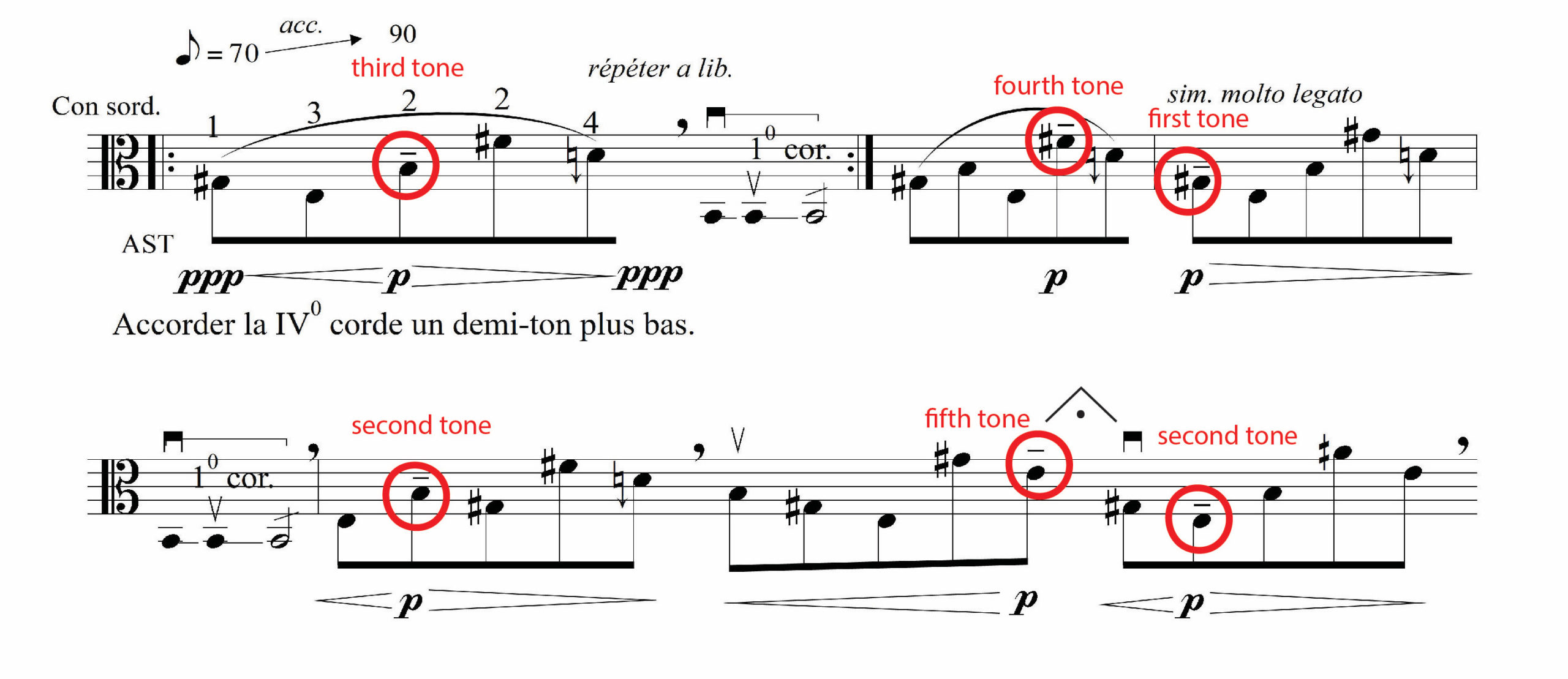
As the form continues, phrases expand, accruing more intermediate pitches and incorporating additional goal points. First, phrases stretch to seven note lengths (Example 4). These phrases continue to point toward a single goal through volume and tempo curves, albeit one notch faster (100–140 BPM) and louder (pianissimo to mezzo piano) than before. Later, phrases of eleven or more notes string together multiple goals within a single respiration (Example 5). Such phrases conceptually fuse two or more action trajectories into a more complex gesture. The simple tensing-and-releasing shape of the earlier gestures becomes cyclical—tense-release, tense-release—reminiscent of how, in our ordinary lives, “the attainment of one type of goal is followed by striving for the other” (Brower 1997/98, 36). Often these multi-goal phrases suggest a terraced phrase structure, where an early goal is achieved, then eclipsed by a more dramatic second goal. For instance, in Example 5 the wide leap from E3 to the second goal tone, B4, overshadows the earlier, less dramatic leap from
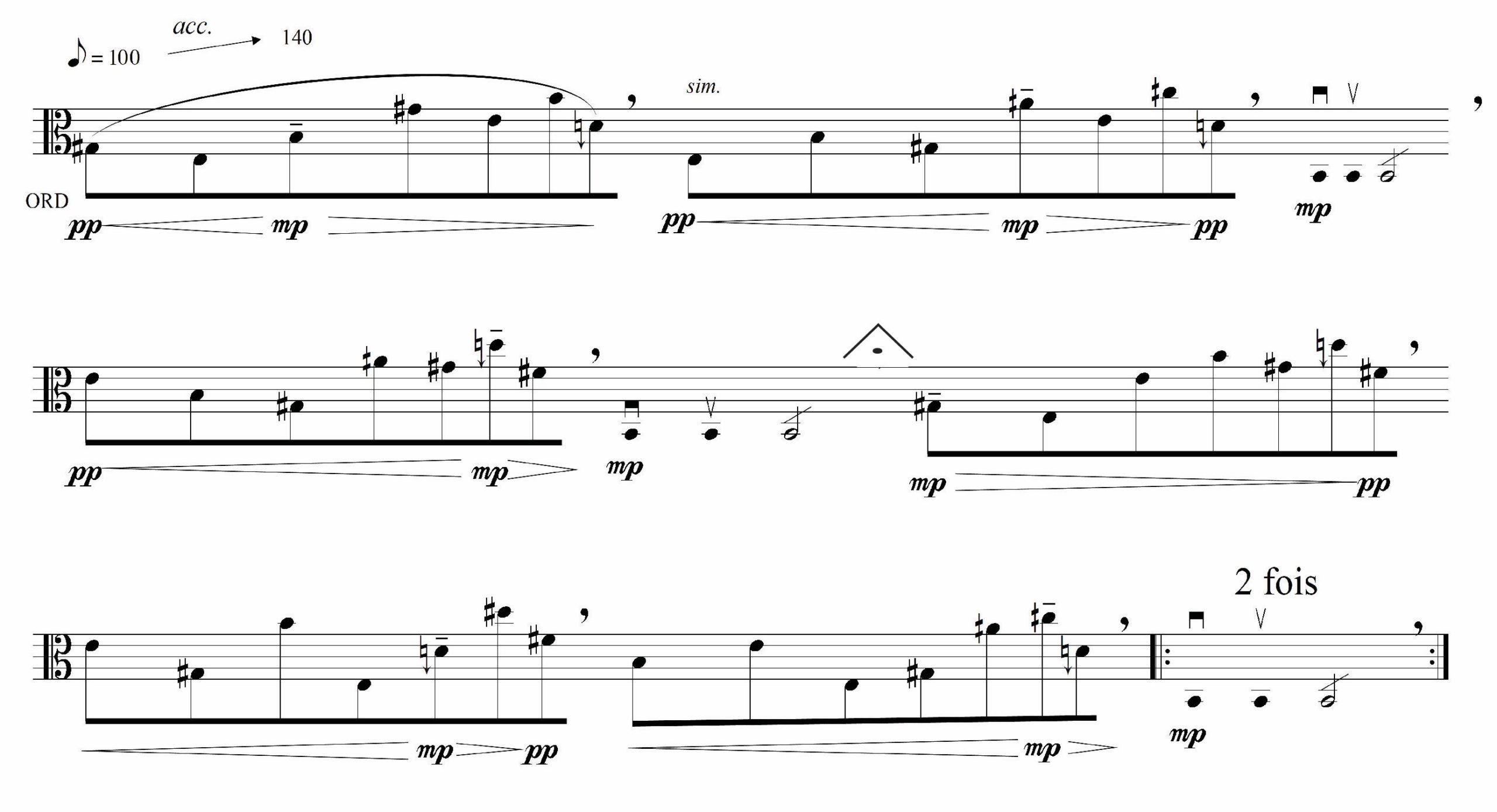
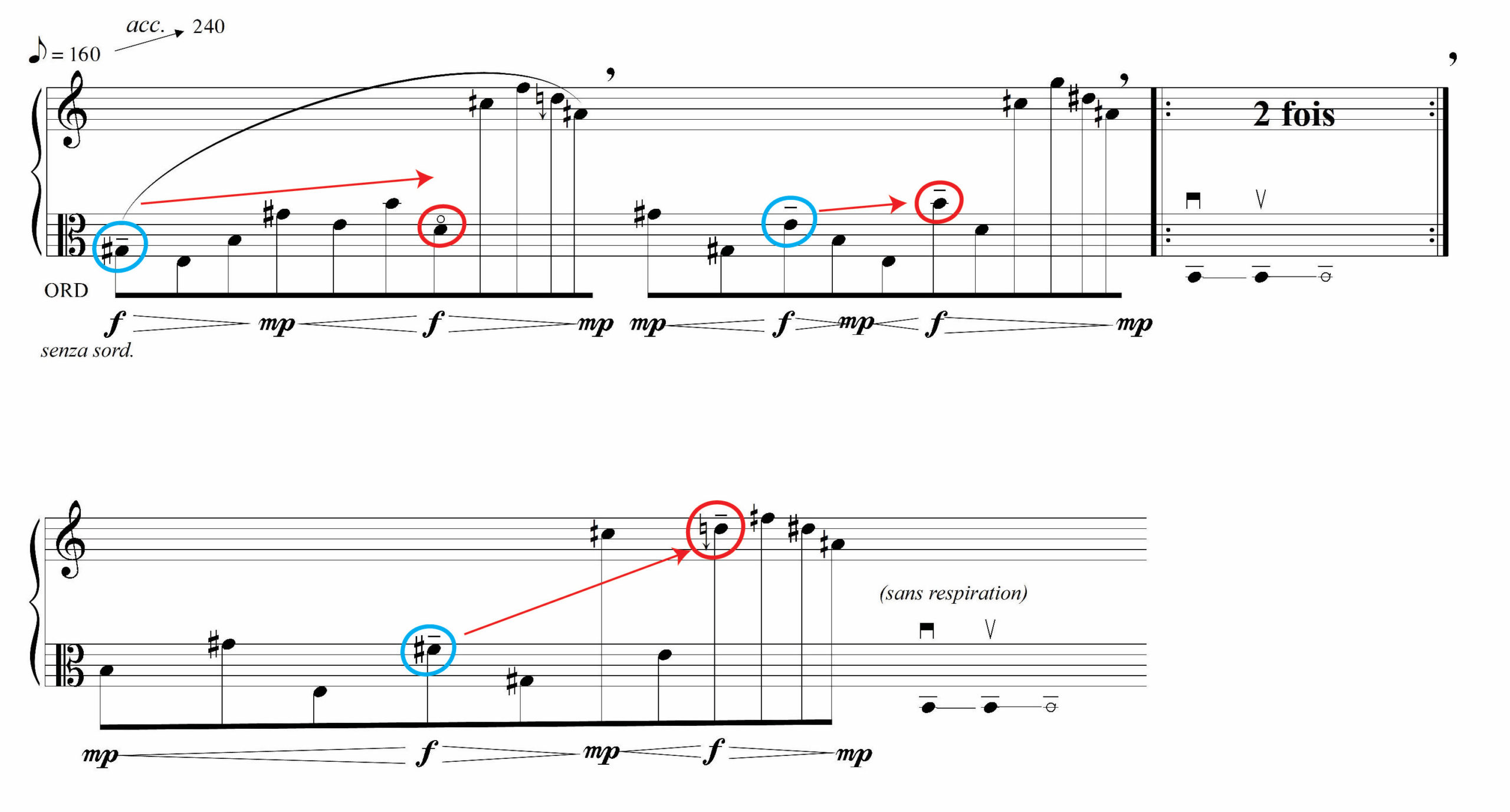
3.2 Tempo and Volume
The gestural essence of the motive is most clearly heard in the tempo and volume curves of each phrase.23 For the vast majority of phrases, volume and tempo increase into the goal tone; after the goal, the sound decays back down to silence, creating a lift or pause separating one phrase from another. The degree and direction of the tempo and volume curve varies from section to section, suggesting the larger form sketched in Figure 1. In general, successive sections operate at louder volumes and faster speeds than preceding sections. The first phrases of the piece begin pianississimo, growing only to piano at each goal tone. The next two sections reach goals at mezzo-piano (second section) and then a full-throated forte (third section). These dynamic increases correspond to greater energy output from the violist and greater tension on the strings. The first three sections thus project a formal progression toward not only louder but also more effortful, exciting, and weighty playing. At the same time, sections feature increasingly rapid tempi. From the initial, relatively constrained range of eighth note equals 70–90 BPM in the phrases of the first section, the second section’s phrases each begin at 100 BPM and accelerate to 160 BPM, while the third section’s phrases each move from 160 to 240 BPM. Not only is each section moving at a faster pace than the preceding one, but the tempo delta also climbs from a modest 29% increase in tempo in the first section (90/70 = 1.29) to a dramatic 60% surge in the second (160/100 = 1.60). The violist’s more effortful movements move at more rapid tempi and navigate more extreme arcs of acceleration. The shape of the respiration is thus amplified with a sense of urgency, purpose, and perhaps even abandon as the piece drives on toward its formal climax.
However, tempo and volume variations are not strictly linear in their appearance. Phrases in the first three sections all accelerate into their goals, but in sections four and five, this trend reverses, and phrases instead decelerate from 190 to 130 BPM.24 At the same time, the trend toward increasing volume is reversed one level, now spanning piano to mezzo forte. At first blush, the slowing tempi and reduced volumes of phrases such as the one shown in Example 6 might seem to reduce the goal-directedness of these respirations. Nevertheless, these phrases can still be heard as gestures conceptually oriented toward goals. Earlier phrases train listeners to anticipate certain goals and to expect them to be approached and left in specific ways. The decelerating phrases of sections four and five are variations in shape, not fundamental character. From the standpoint of performance, slowing into a goal invites a more dramatic execution and allows the performer to linger on the goal tone, giving it a greater sense of accent and weight. Conceptually, slowing down suggests a more monumental arrival and brings with it the attendant exertions required to reach a goal point—an experience reminiscent of struggling to reach a ledge we are climbing, or to surmount the last few stairs in a tall building. Following this dramatic diversion in sections four and five, the sixth section restores the accelerating orientation with a markedly increased tempo (from 190 to 300) and dynamic range (fortissimo goals).
Stepping back, the overall pattern of these six sections traces the respiration shape, writ large: the first three sections build in tempo and volume just as the melodic phrase does (inspiration), the fourth and fifth sections counterbalance this directionality with decreasing tempi and reduced volumes (expiration), and the sixth section drives forward into the climactic section (another inspiration). The metaphor of respiration thus explains the subtler form laid out by the tempo and dynamic variations, in which general motion toward a climax incorporates a digression in the opposite direction.
3.3 Suffixes
A further element of variation is the addition of a suffix to later phrases. I call these suffixes because they are appended to the main respiration statements, beginning after the conclusion of the dynamic, goal-directed motion of the phrase proper. In contrast to the dynamic shapes of the respirations that precede them, suffixes are more sedate, composed of steady movements that maintain or reduce volume.25 In fact, many of Prologue’s suffixes mimic the acoustic aftereffects of their respirations. For example, the earliest and most prominent suffix is an “echo” (Grisey’s term).26 Like its environmental counterpoint, an echo repeats the two preceding pitches and falls in volume, as if the end of the respiration is resonating in the space. The echo is a suffix to the main phrase because it is not gestural: its apparent adherence to the natural laws of acoustics sublimates the sense of an intentional agent pushing against the physical laws of a tonal space.27 Rather, echoes catalog the ongoing resonance of an agent’s sounding actions in a space.
A simple instance of echo is shown in Example 7. The final two notes of the preceding melody repeat in an even, rocking rhythm.28 The rote repetition of these two pitches and the unchanging volume projects a static quality that, in contrast with the dynamic curve of the preceding respiration, suggests an “ending” formal function. In the example, the shape of the respiration is depicted with a rising and falling red curve, while the static qualities of the echo are shown with a blue line.
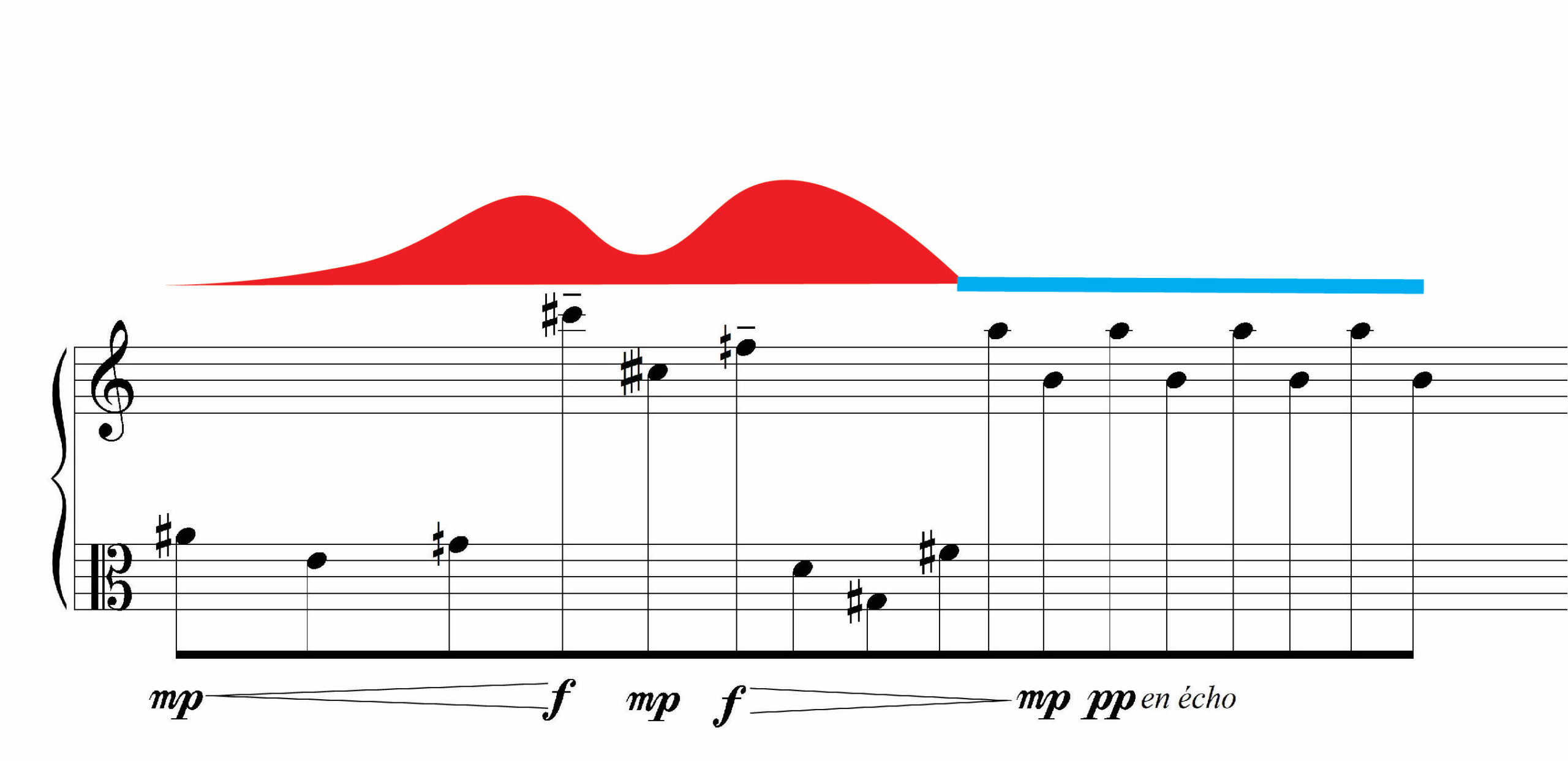
Later echoes are more substantial and incorporate their own variations. Example 8 reproduces a section where extended echoes contribute to a marked change in character. The first two respirations proceed normally, with no added suffixes, before the third phrase introduces an eight-note echo that eclipses the main phrase itself. But the echoed pitches are no longer mere repetitions; rather, they descend in frequency by alternating quarter tones, “decaying” through the echo as if the sound is naturally distorting as it bounces around the space and encounters physical resistance. Two more suffix-less phrases follow (phrases four and five), leading to another extended decaying echo in the sixth phrase. This echo is in a substantially lower register and accompanies a shift in timbre from the sul tasto that characterized the first six phrases to the contrasting sul ponticello. The seventh phrase restores the echo to the upper register but inverts the order, beginning the pair with the low pitch (i.e., low-high replaces high-low). This echo is then cut off mid-cycle, after the first pitch of the fifth pair of pitches. After a suffix-less eighth phrase, the extended passage is capped by a dramatic echo in the ninth phrase. The ninth phrase’s respiration moves to regularly alternating bowing (down-up), in contrast to the longer bowing patterns heard thus far. This rapid bowing continues into the phrase’s echo, heightening the cyclical sense of the repeating pitch pair. The ninth phrase’s echo further rounds out the larger passage with a more dramatic shape, including a louder dynamic (mezzo piano in place of earlier echoes’ pianissimo), contrasting timbre (alto sul ponticello opposes the first phrase’s alto sul tasto sounds), and alla corda bowing.
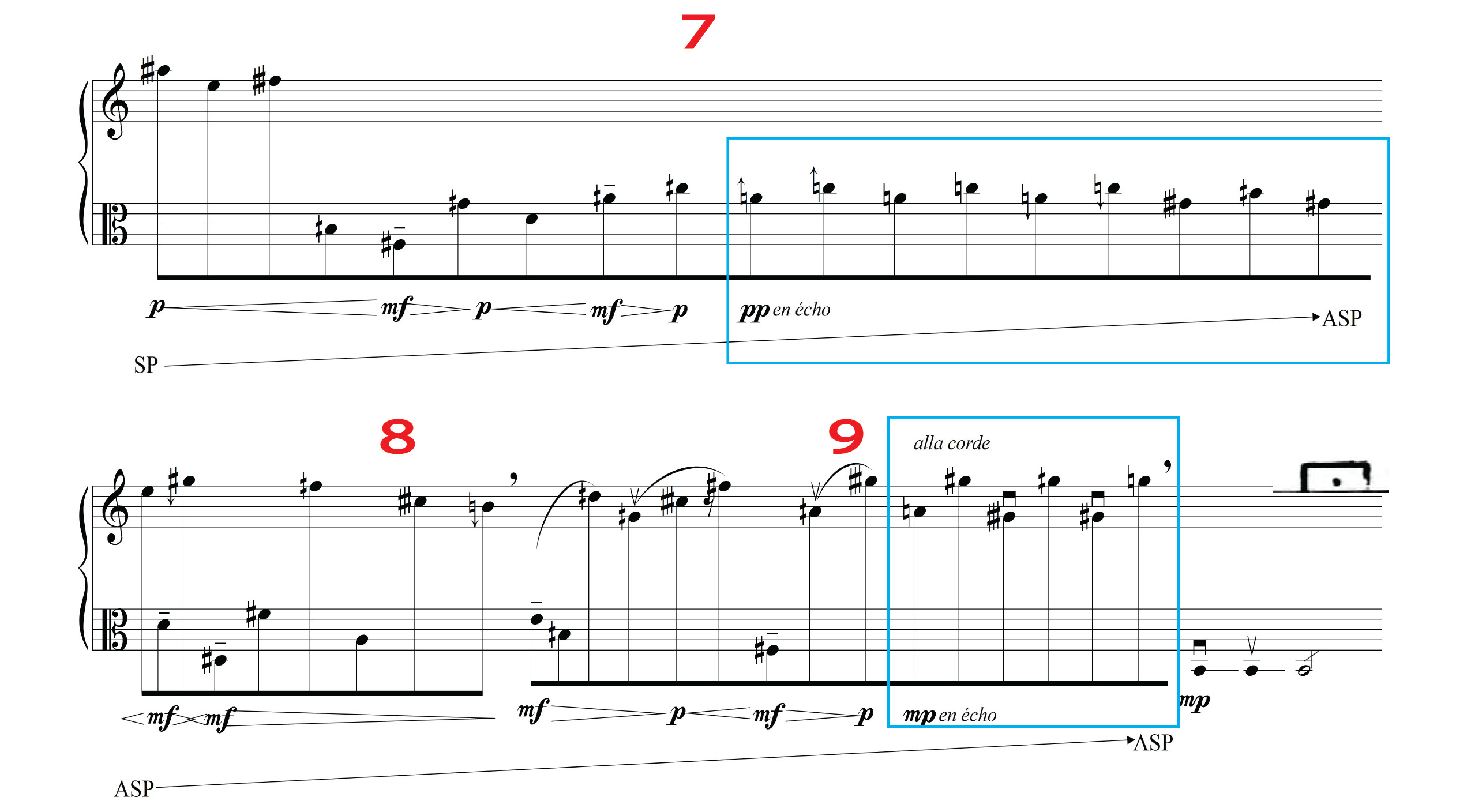
Later in the piece, another kind of suffix—a rapid, alla corda tremolo—is introduced in the final approach to the climax. An early instance of the tremolo appears in Example 9, which directly follows the dramatic conclusion of Example 8. Where echoes dissipated the energy of the preceding phrases with falling pitches and volume, tremolos maintain energy and volume. They reduce the sense of repose between phrases, both aurally (they sound busier and more active) and gesturally (the violist moves more quickly and frenetically; the tremolos come from agential actions, not environmental echoes). At first heard only in select phrases, tremolos soon appear at the end of every phrase, contributing to the building energy and excitement before the climax.

3.4 Dissolution
The tremolos continue until the respiration motive itself dissipates into descending glissandi moments before the climax. First, the violist transitions to poco portamento playing, then molto portamento only forty-five seconds later; see Example 10. Notes quickly blur together; discrete pitches flow into uninterrupted action trajectories. The move to portamento culminates in a flattening of the respirations into simple descending lines. Example 11 examines the gestural changes involved in this final variation. Written accents on alternate pitches supplant the register and contour accents of earlier phrases. Nevertheless, the overall goals of these phrases are clearly at their nadir by the end of each line. In fact, this end-orientation extends to the violist’s engagement with the instrument: every phrase requires a linear motion on the instrument (from near the bridge to the fingerboard). The change is visually apparent when we watch a performance and can see the performer sliding down the strings in each phrase. However, a listener with even a passing familiarity with stringed instruments can understand this change in fingering technique from sound alone, simulating the literal linear motions through space alongside the metaphorical descending motion through pitch space.
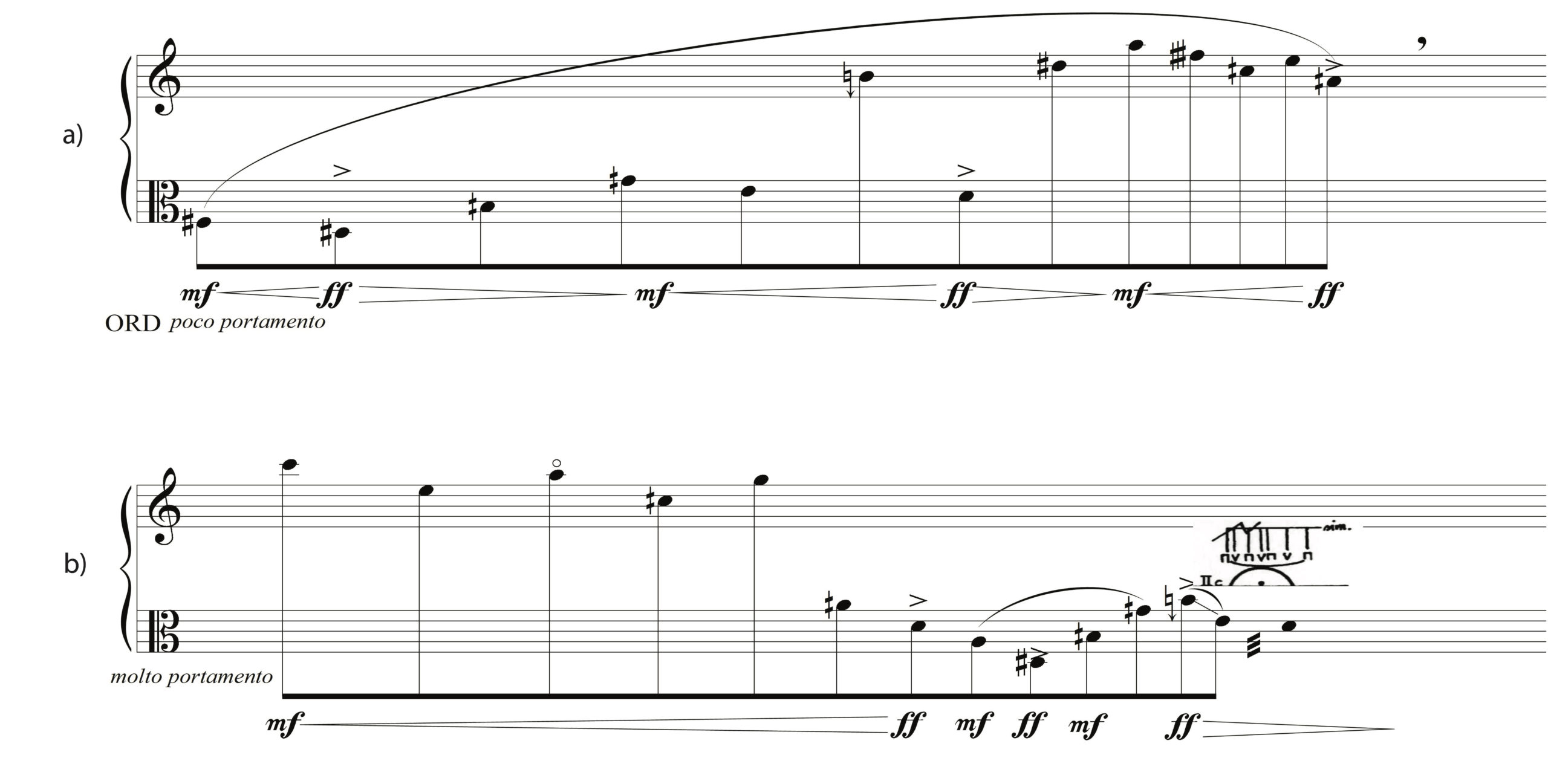
The descending lines lead directly into the climactic section, where the smooth sliding motion converts into a series of continuous, scratchy glissandi. In a gestural sense, the climax reveals the goal-directed, gestural essence that unites the motivic variations. The subtleties of the melody’s tempo, pitch contour, and rhythm are replaced by fluid movements on the instrument from one position to another: gestural motion beyond melodic convention and discrete phrase.29 But the other two formal elements, opposition and tension, also reach their conclusion in this moment. Therefore, before discussing the climax in greater detail, I need to turn back to the opening moments of the piece to trace the heartbeat’s contributions to the form.
4. Opposition
A process of motivic opposition unfolds alongside the variations of the respiration, enriching the larger form of Prologue. This opposition is introduced when the heartbeat follows the first respiration and repeats with it (Example 12). Just as the respiration motive mimics certain aspects of human breathing, the heartbeat motive’s short-long rhythm on an open string (detuned to B2) clearly imitates its namesake process.30
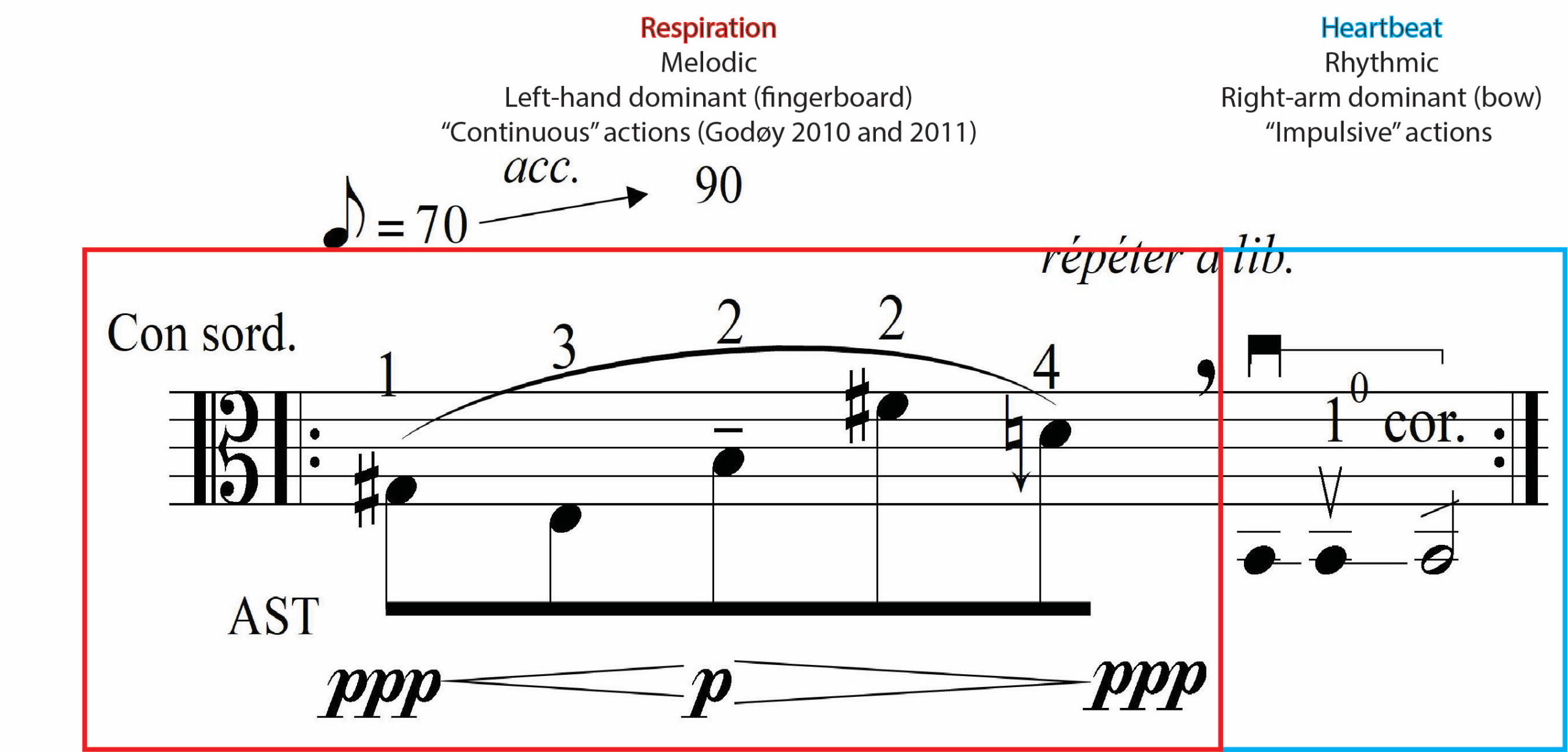
Opposition arises from the contrast between the dynamic motion of the respiration and the cyclical stasis of the heartbeat. The annotations in Example 12 summarize these contrasting elements. The respiration is primarily melodic: its focus is on pitch contour and expressive shape, and although its component notes are conceptually (notationally) equal, the dynamic tempo of the accelerando prevents hearing an underlying beat or meter.31 The heartbeat is primarily rhythmic: lacking pitch contour and presenting only a single pitch, its focus is on the short-long rhythm and the sharper accents and articulations it requires. This opposition extends to performance technique in the different roles of the right and left arms and hands.32 To produce a respiration, the violist presses down the strings with their left hand in the correct fingerings, while their right arm draws the bow slowly across the strings to make them resonate. In these first, simple phrases, respirations are produced by one long bow stroke—a physical manifestation of the sense of a unified gesture-phrase. By contrast, the heartbeat relies almost exclusively on the actions of the right arm, which plays sharp alternating bow strokes on the open string. The left hand is uninvolved, except as a support for the instrument and as a counter to the bow’s push into the strings. More generally, the respiration and heartbeat represent different types of sound-producing actions (Godøy 2010, 2011). The respiration arises from “continuous” actions, in which energy is continuously applied to the instrument: the uninterrupted bow stroke through all five notes. Continuous actions tend to create sustained, singing sounds—in other words, they support melodies, phrasing, and legato playing. The heartbeat, meanwhile, requires “impulsive” actions: short, repetitive bursts of energy. Impulsive actions generate rhythms and pulse streams with more differentiated articulations, as in the accented down-bow/up-bow pattern of the heartbeat.
The distinction between continuous and impulsive actions explains how non-violist listeners can conceptualize the gestural opposition between the motives, even without direct or explicit knowledge about how they are played. From the perspective of Arnie Cox’s (2016) Mimetic Motor Imagery (MMI), listeners can cross-modally simulate these categories of sound production on their own instrument or with their voice.33 Alternatively, Mariusz Kozak (2015) proposes that listeners’ spontaneous movements in response to sounds represent a motor-intentional understanding of music independent of the actual, physical movements of performance. Listeners tend to move in predictable ways for certain types of sounds, producing flowing motions for continuous legato lines (as in Prologue’s respiration) and sharper or more abrupt movements for impulsive sounds (as heard in the heartbeat) (Kozak 2015, [3.15]). Finally, studies of overt movements in response to sound offer insight into covert responses by revealing the motor-intentional activity of interpreting sounds through the medium of analogous bodily movement. Even when the overt response is suppressed, motor imagery can be heard in, and enacted alongside, musical sounds and participate in musical imagery (Godøy 2018, [8.3]).
4.1 Heartbeat as Boundary
The heartbeat principally serves a segmentation function: its rhythmic contrast to the flowing melodies of the respiration breaks up the latter’s unfolding variations into discrete chunks. The heartbeat is not heard after every respiration; more often, it serves as a divider, interrupting one phase of the respiration’s development and heralding a new variation in the following section. As rare and memorable segments that break up the respiration’s development, heartbeat statements provide significant formal “cues” (Deliège and Mélen 1997) that can articulate boundaries and help enable listeners parse Prologue’s nearly fifteen-minute form.34
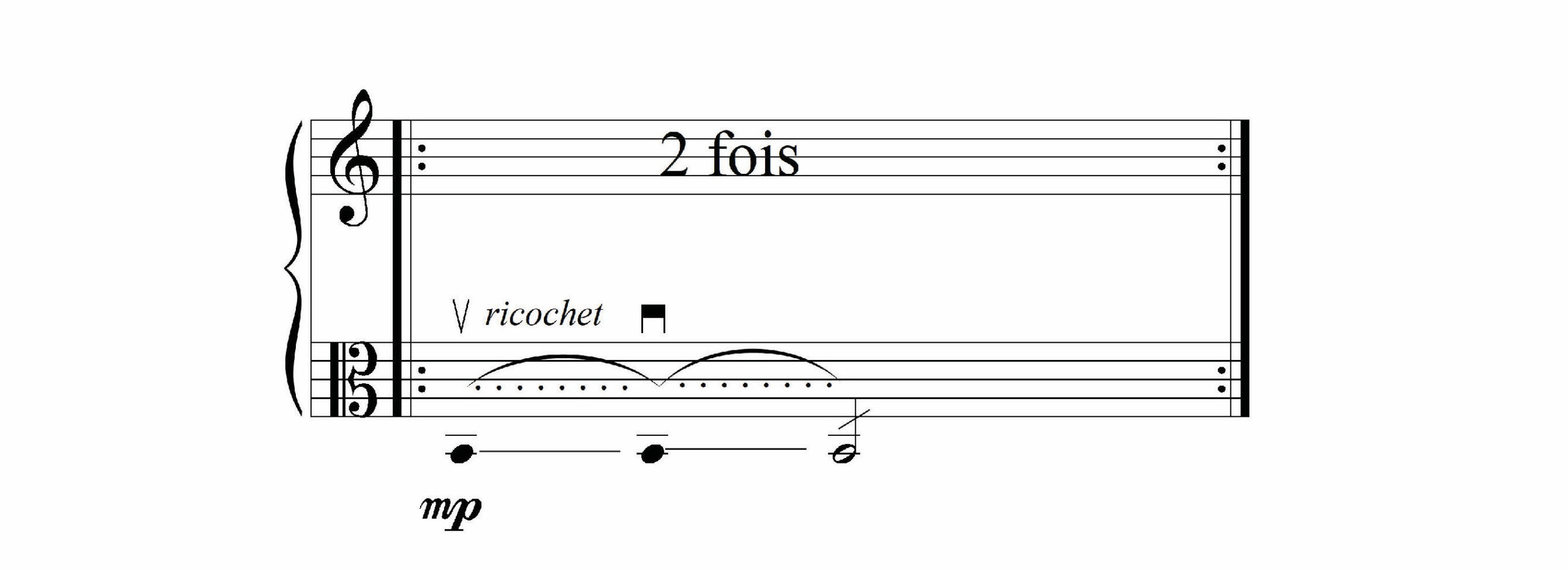
Example 13. A timbral evolution of the heartbeat, played with ricochet bowing in Grisey, Prologue, 3:2. Note that this instance of the heartbeat marks the transition into molto portamento respirations.
At first, one heartbeat occurs after every two or three respirations (refer to Example 3). Later, heartbeats are heard only after many consecutive respirations. However, these rarer heartbeats stand out, for they are now repeated three, four, five, or more times.35 Heartbeats are also subject to the timbral evolutions heard in the build-up to the climax (and discussed further in the analysis of tension below). For instance, in Example 13 the violist plays a heartbeat ricochet, creating additional (somewhat uncontrolled or random) articulations as their bow bounces freely within the overall short-long rhythm. The impulsive character is preserved, while the strict rhythm is loosened, and the timbre diffused, as part of the move toward unified sliding lines in the upcoming climax.
4.2 Blending Motives
The opposition is ultimately resolved in the climax, where the distinctive playing methods and qualities of respiration (melody) and heartbeat (rhythm) blend into a unified glissando gesture incorporating both of the violist’s limbs. Crucially, this blending is hinted earlier in the piece, when characteristics of the heartbeat rhythm intrude into or “contaminate” (Baillet 2000, 111) the respiration. Example 14 reproduces the first instance of this motivic blending. Following several consecutive heartbeats, a respiration melody begins. But in lieu of its usual flowing rhythm, the melody unfolds in lilting pairs of durations (short-long). Moreover, in place of the respiration’s usual continuous bowing—with many notes in a single bow stroke—alternating down-up bowing patterns break up the melody according to its short-long rhythms. These changes attenuate the goal-directedness of the melody by fragmenting the arch-shaped contour. In place of this contour, the lilting rhythms create several localized goal points: each long note feels like a miniature arrival point in the overall phrase. The result is a jagged melody with a more varied and dramatic shape.
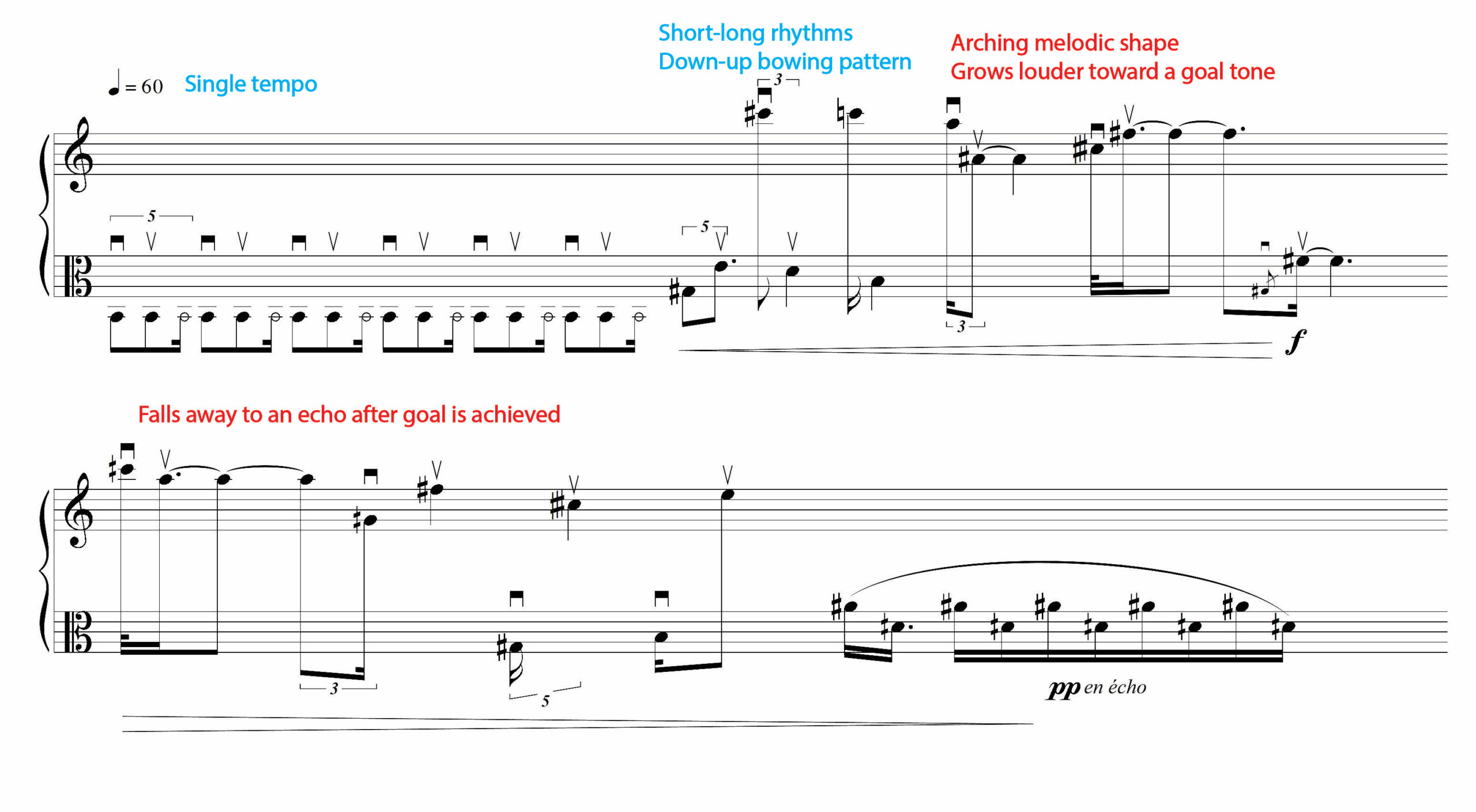

A similar transformation unfolds more gradually a few phrases later, shown in Example 15. The intrusion of heartbeat characteristics into a respiration begins with the marking très régulier and the establishment of a steady tempo of eighth note equals 130 BPM. Alternating (down-up) bowing, again borrowed from the heartbeat, further bends this respiration out of its fluid temporal domain and into a more periodic or metric type of time. After eight isochronous eighth notes, the phrase again transitions to short-long rhythms. This lilting rhythm materializes gradually. Complex rhythmic ratios lengthen one note and shorten the other on each successive pair. Grisey’s brackets in the score show that while each pair of notes is to last a quarter note in duration, each pair divides that quarter note by nine, seven, five, and three, giving durational ratios within each bracket as 4:5, 3:4, 2:3, and 1:2, respectively.36 This process culminates in a forte arrival on a sixteenth note–dotted eighth note rhythm, leading directly into three statements of the heartbeat in the same rhythm to close off the section.
4.3 Culmination
The fusion of the respiration and heartbeat just described dovetails with the shift to descending glissandi respirations (Examples 10 and 11) and the final instance of heartbeat-as-boundary (the ricochet statement, Example 13). Henceforth the opposition becomes less a motivic contrast and more a parametric contest traceable to the associated limbs. Modified bowing actions (heartbeat, right arm), especially increased bow pressure, obscure the changing pitches of the melody (respiration, left hand). The sonic focus turns from pitch and contour to timbre and impulse. At the same time, the switch to portamento transforms the left hand’s role from one of delineating discrete pitches on the continuous strings to emphasizing those strings’ continuity via non-discrete pitches and sliding lines. The contest culminates at the climax, where right arm and left hand move synchronously to generate its extreme sounds. The left hand slides around the fingerboard, while the bow slides up and down the bridge between sul ponticello and sul tasto. The extremely loud sounds (triple forte), crunchy timbres (extreme bow pressure), and smooth motion sublimate the independent actions of either limb as well as the characteristic parameters of either motive. Melody and rhythm give way to sound and noise. This brings us to the last element of the form—the increasing tension associated with these timbral-bodily changes—which comes to the fore in the approach to this climactic section.
5. Tension: Extended Techniques and Bodily/Instrumental “Noise”
Prologue’s increasing tension projects the performer’s relationship with the instrument. The sounds seem tense because they encode the exertions of the performer. They are also tense because listeners can imagine or simulate the actions that might produce such sounds—and even if these are not the exact actions involved in the performance, they will most likely mimic the effort of the sound production. While they seem like secondary, subjective judgements of an objective acoustical signal, listeners are more likely to identify directly with concepts of effort, exertion, and (bodily) tension than with the signal itself. Andrew Mead observes that volume tends to come across “not so much as strength of signal but as index of effort” (1999, 11), while very high and very low pitches project the “extra ‘oomph’ and nerve required to bring them off” (9).37 The climax of Prologue sounds climactic and tense not because it is acoustically loud and timbrally dense, per se, but because these characteristics reflect the effort and energy required to produce them.
More broadly, the concept of tension engages a sense of bodily balance. Judgements of musical tension typically follow a cycle of tensing and releasing, which are related to ubiquitous cycles of tension and release in everyday experiences such as breathing. The performer’s actual balance is not necessarily accessible to a listener, yet the sounds they produce reflect their balance or imbalance.38 The tensing and releasing shape of Prologue’s respirations, for example, could also be described in terms of a move away from and back to bodily balance. In fact, this movement is visible in the “ancillary” body movements of performers, whose posture tends to trace (and thus visually heighten) the balance-imbalance-balance path of their musical phrasing.39
In Prologue, the increasing complexity of the respiration (variation) and the intrusion of elements of the heartbeat (opposition) contribute to a general increase in tension over time. The performer’s movements become more energetic, effortful, wide-ranging, and extreme. Phrases are played at successively faster tempi, with more dramatic accelerations or decelerations, more pitches, and additional peaks. They increase in volume, calling for more effort and greater contrasts of effort within phrases. Phrases cover a wider range in pitch and instrumental space, corresponding to larger movements and leaps in physical space. Finally, phrases migrate to the extremes of the instrument and viola technique, as very high pitches become commonplace, leaps between registers dominate phrases, and extended techniques shift where energy is applied and how the body interfaces with the instrument.
This last point is perhaps the clearest indication of increased tension. In the latter stages of the piece, extended techniques generate noisier timbres that viscerally communicate effort and energy. Defined broadly as unusual ways of playing an instrument, extended techniques typically create unusual timbres by manipulating familiar instruments in unfamiliar ways.40 Extended techniques in Prologue can be generally conceived as variations in the amount, location, and type of force that a performer applies to their instrument. Applying more or less force alters volume and timbral quality. For example, increased bow pressure on the viola creates a louder and scratchier sound that, if pushed to the extreme, supplants pitch with scratchy noise, highlighting the materiality of the viola string over its musical possibilities. Changing where the force is applied to the instrument transforms the attack and resonance of a sound. For instance, playing on the fingerboard (sul tasto) thins out the timbre and makes the sound more fragile, while playing on the bridge (sul ponticello) adds more overtones to the sound, thickening pitch into a more complex timbre. Finally, alterations in the type of force drastically transform the sound of an instrument. A Bartók pizzicato has a much harsher articulation and a drastically shortened resonance compared to the same note played with ordinario bowing; the sound of striking the strings with the wood of the bow (col legno battuto) is quite unlike drawing the hair of the bow across them.
In Prologue, this type of timbral tension arises primarily from increased bow pressure. The increased volume and timbre of bow pressure techniques index the violist’s less balanced bodily position and increased forcefulness. The harsh timbres signal bodily tension—the violist exerting their muscles, pressing their bow down—as well as instrumental tension (the tension of the viola strings under pressure). Beyond such a direct matching of musical tension to gestural tension (Cox’s intra-modal imagery), there are cross-modal, amodal, and conceptual aspects to this sense of tension (Cox 2011). The tension can be analogized with pushing a listener’s own (non-viola) instrument or voice beyond its limits, such as overblowing a flute or singing verging on screaming (this is cross-modal imagery). Or the viola’s timbre could be related to metaphors that link hearing and touch, as in the common comparison of scratchy timbres to the texture of rough surfaces (amodal imagery).41 Finally, a listener familiar with Grisey’s aesthetic can conceptually associate the sounds with Grisey’s ideas about timbre and harmony—wherein feedback, static, and white noise serve as antithetical foils to “pure sounds” and harmonic spectra (Grisey [1982] 2008, 45–48).42
In the final stages of the form, tension-generating extended techniques overtake gesturing respirations and heartbeats as the primary form-defining actions. Like all aspects of this piece, the change is gradual. First, the violist is instructed to play “increasingly vehement and jerky,” crushing the bow into the string, in Example 16a. According to Grisey’s notes to the performer in the score (reproduced in Example 16a), tuning becomes less important here. The violist should allow the “crushing” timbre to override the pitch focus of the respiration, while still tracing the contour of the line. The trend toward greater timbral tension continues when “extremely violent and rasping” playing and “exaggerated” bow pressure obscures the melodic contour in Example 16b. Coupled with the contemporaneous change to portamento, the rasping bow pressure helps pave the way for the dissolution of the motive into the climactic passage.


Example 16b. “Extremely violent and grimacing. Exaggerated bow pressure.” Performance instructions in Grisey, Prologue, 3:6.
Example 17 reexamines the dissolution of the respiration into descending lines in terms of extended techniques. Growing out of the portamento style noted above, rapid concluding slides gradually eclipse and then subsume the phrases of this section. The slides begin as the interval B4 to E4. One additional pitch is added to the slide of each subsequent phrase for twelve iterations, eventually yielding thirteen-note slides that outlast their corresponding respirations. These slides mostly descend, but there are significant countermoves through upward leaps, especially at the starts of phrases. The upward leaps open space for the following descents: for instance, the eleventh and twelfth phrases leap upward to new heights before descending from this apex for the rest of their durations. Further, initial pitches track higher and higher, ascending chromatically from phrase to phrase. These high register pitches project tension via the tautness of the strings, as well as through the added pressure required of the violist’s fingers as they hold down the strings so near the bridge. Tempo, articulation, and dynamics further contribute to the building tension of this passage. Phrases accelerate to a breakneck pace. Each descent takes less time than the last; the violist must traverse the entire instrumental space ever more rapidly. Further, intermediate accents accrue to every “pitch” within the line. The violist is paradoxically asked to smoothly slide downward at a breakneck pace while emphasizing twelve to thirteen points within that slide. Finally, dynamics are pushed to the extreme, arriving at fortissimo near the bottom of page three and growing louder from there.43
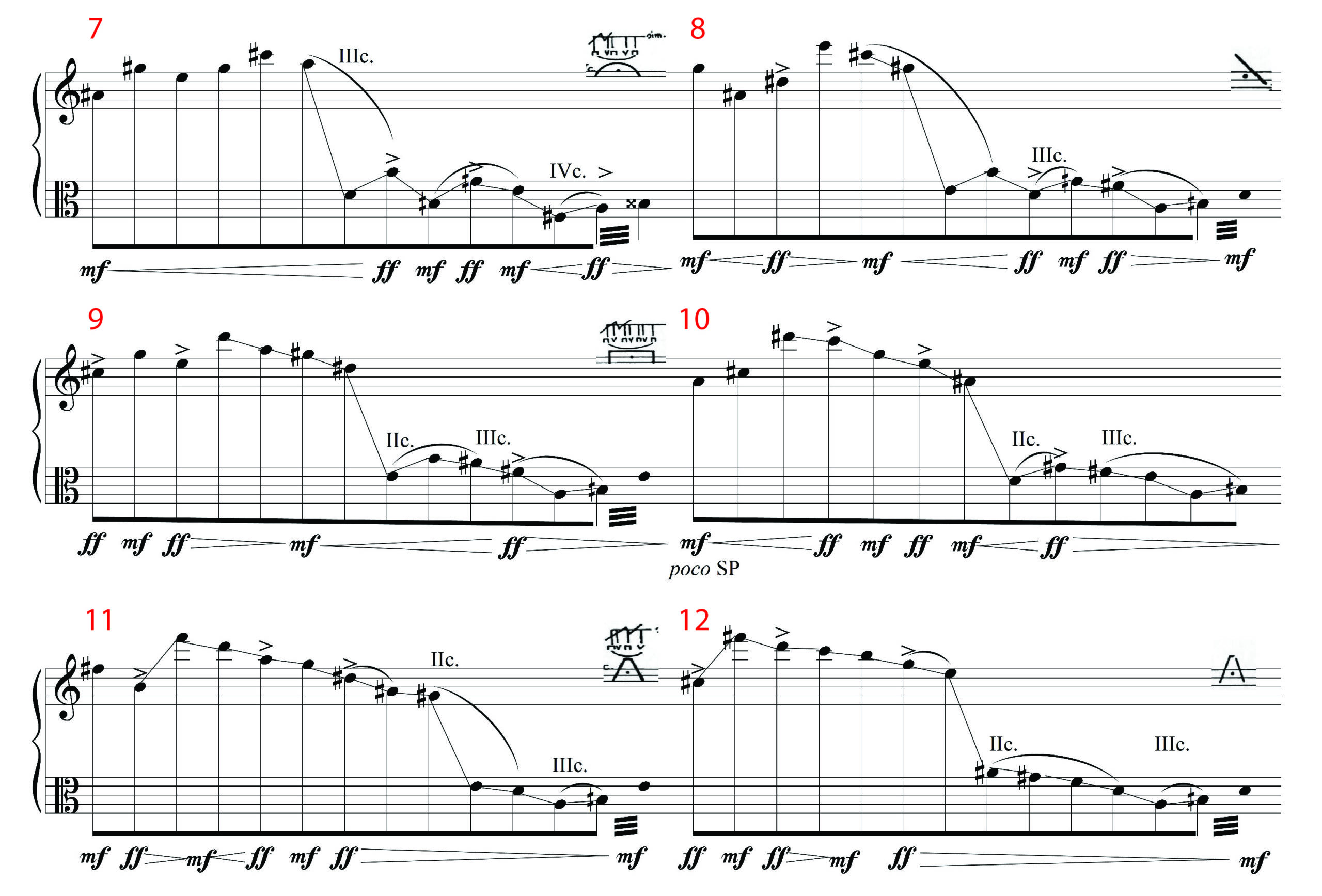
Overall, the violist pushes their body and instrument to extremes as they play ever more rapidly, forcefully, and loudly. Listeners, sensing the effort required in this performance, can anticipate an arrival—a climax—followed by a winding-down of this unsustainable level of bodily-musical tension.
The climactic section, reproduced in Example 18, is announced by a tremolo that arrests the accelerating trajectory of the preceding descending phrases. What follows is a series of noisy glissandi played at the edge of bow pressure. All notated pitches represent approximate points on the instrument rather than important tones—pitch is indeterminate in the signal because the bow pressure stifles the resonance of the strings. The violist is instructed to outline a contour while abandoning precision and restraint as they pour unbridled energy into the instrument. But this energy does not necessarily translate into volume. There is so much bow pressure that sound itself is almost stopped. Moreover, although the passage is marked triple forte, the viola’s strings are damped by the pressing of the bow. The dynamic marking refers not to audible decibels but to the intensity of the violist’s actions. This intensity comes across in sound as the scratchy timbre, demonstrating how sound can encode volume and effort beyond sheer amplitude.

The climactic section concludes with tension of a different kind; see Example 19. The violist gradually reduces bow pressure, returning to ordinario sounds. They move their left hand up to the tuning pegs and slowly retune the lowest string from B2 up to D3 over the course of nearly ten seconds. At the same time, they slide the bow up to sul tasto, then alto sul tasto, and finally out onto the fingerboard and near the fingers (“près des doigts” indication in the score). The pitch of this passage changes slowly, and by unusual (mechanical) means, while the timbre thins and diffuses as the bow encroaches on the left hand’s realm. All the while, the phrase fades in volume as the violist continues to release bow pressure and reduce energy. The climactic passage ends in silence and repose.
This is not tension by sheer force, as was the case in the passages preceding the climactic passage. Rather, here we have a uniquely body-based tension, stemming from the fragility of the sounds and their delicate means of production. When watching a performance, the tension of this passage is evident in the visually delicate actions of a violist operating at the extreme end of their instrument, imperiling their balance and hold on the instrument (intra-modal imagery).44 But even without seeing these specific and unusual movements, the quiet, foreboding tension of this passage can be sensed and represented in other body-based ways. For instance, listeners might relate the slow-moving and soft sounds to similar actions on an instrument they play (cross-modal imagery). Brass players cannot relate to the string-instrument specific actions involved in this passage—but they can recognize the gentle exertions of soft playing that hold for both brass and string instrumental performance. This passage’s tension could also be traced to the cognitive difficulty of predicting what will happen next in the context of slow and gradual change. Tension also arises in the perceptual task of focusing attention on an extremely quiet passage that is getting softer, points toward no discernable goal, and concludes with stillness and silence. The key to hearing this passage is understanding the tension inherent in its production and imagining the bodily correlates of the sounds it includes. An embodied reading imbues the passage with meaning: a human meaning beyond acoustic facts and practical effects.45
Conclusions
In the conventional view, spectral music applies acoustic and psychoacoustic facts and electroacoustic techniques to composition for mostly acoustic, orchestral instruments. In other words, spectral music is primarily about “sound” itself and its manipulations in time. Like the idea of absolute music, it does not reach outside itself to reference: in the words of Grisey’s famous dictum, “literature…mathematics…theater, the plastic arts, quantum physics, geology, astrology, or acupuncture”; instead, the only “model is sound” (Grisey [1982] 2008, 53). The most striking example of this privileging of sound is Grisey’s Partiels, the third movement of Les espaces acoustiques and arguably the locus classicus of spectral music. The E1 spectrum presented at the opening of that piece mimics the unfolding of the eponymous partials of a trombone’s E in a succinct proof of concept for instrumental synthesis, a technique Grisey innovated in which live instruments stand in for sine tone generators, analogously recreating analyzed spectra as an electroacoustic composer might, but via acoustic means. Similarly, Prologue could be considered an experiment in melodic writing based on spectral theory; an early application of Grisey’s ideas about temporal experience to composition (Hennessy 2009); and an exploration of how Gestalt theory, psychoacoustics, and repetition can be harnessed to create new musical experiences (Grisey n.d.).
But this approach elides the essential role of bodies: both the expressive bodies of performers and the enacting bodies of listeners.46 Prologue’s melodic variations, motivic oppositions, and building tension depend on a performer’s enactment of Grisey’s ideas and instructions. The gradual unfolding of the three formal aspects I identified here highlights the bodily and material origins of the sounds and relationships in this piece.
Rather than supplanting past perspectives, my embodied approach can reframe and recontextualize them. The extreme, hypnotic degree of repetition that Grisey highlights in his program notes (n.d.) requires a performer to concentrate and execute hundreds of similar phrases over a fifteen-minute span, all while imbuing each with character and motion to maintain interest and overall affect. The layers of temporal experience explored by Jeffrey Hennessy (2009)—and inspired by Grisey’s (1987) own writings—owe their origin to embodied engagements between the performer, who interprets the tempi and durations, and the listener, who feels musical time unfold in relation to their body. Or as Kozak (2020) would have it, the listener enacts or “secretes” musical time in the embodied encounter with the unfolding music. And the subtle timbral evolutions prized by spectral composers and infused into Prologue’s DNA can be traced back to the movements (such as extended playing techniques) and materials (instrumental characteristics, resonance qualities, room acoustics, etc.) essential to their sounding. Sound is action, and transformations of sound are transformations of body and instrument. Music is more than organized sound: it is an agglomeration of sound and action, and its sonic structures are always rooted in and experienced with their embodied correlates (affect, agency, etc.). Spectral music may be “about” sound, but sound is about action. This article, then, does not so much reject as reframe existing spectral studies in a more comprehensive analytical framework that acknowledges the role of body, working in concert with ears and mind, in parsing the complex timbre-harmonies, temporalities, and affects of spectral forms.
Joseph R Jakubowski
Harvard University
3 Oxford St
Cambridge, MA 02138
joseph_jakubowski@fas.harvard.edu
References
Acitores, Alicia Peñalba. 2011. “Towards a Theory of Proprioception as a Bodily Basis for Consciousness in Music.” In Music and Consciousness, edited by David Clarke and Eric F. Clarke, 215–230. New York: Oxford University Press.
Baillet, Jérôme. 2000. Gérard Grisey: Fondements d’une écriture.. Paris: L’Harmattan.
Brower, Candace. 1997/98. “Pathway, Blockage, and Containment in Density 21.5.” Theory and Practice 22/23: 35–54.
Cizmic, Maria. 2010. “Embodied Experimentalism and Henry Cowell’s The Banshee.” American Music 28 (4): 436–458.
Cox, Arnie. 2011. “Embodying Music: Principles of the Mimetic Hypothesis.” Music Theory Online 17 (2). Accessed 19 October 2020. https://mtosmt.org/issues/mto.11.17.2/mto.11.17.2.cox.html.
———. 2016. Music and Embodied Cognition: Listening, Moving, Feeling, and Thinking. Bloomington: Indiana University Press.
Cusick, Suzanne G. 1994. “Feminist Theory, Music Theory, and the Mind/Body Problem.” Perspectives of New Music 32 (1): 8–27.
Davidson, Jane. 2005. “Bodily Communication in Musical Performance.” In Musical Communication, ed. Dorothy Miell, Raymond MacDonald, and David J. Hargreaves, 215–235. New York: Oxford University Press.
Davies, Hugh. 2001. “Instrumental Modifications and Extended Performance Techniques.” In Grove Music Online. Oxford Music Online. Accessed 19 October 2020. https://doi.org/10.1093/gmo/9781561592630.article.47629.
Deliège, Irène, and Marc Mélen. 1997. “Cue Abstraction in the Representation of Musical Form.” In Perception and Cognition of Music, edited by Irène Deliège and John Sloboda, 387–412. East Sussex: Psychology Press.
De Souza, Jonathan. 2017. Music at Hand: Instruments, Bodies, and Cognition. New York: Oxford University Press.
Féron, Francois-Xavier. n.d. “Analyse de Prologue de Gérard Grisey.” Accessed 7 July 2019. http://brahms.ircam.fr/analyses/Prologue/.
Fisher, George, and Judith Lochhead. 2002. “Analyzing from the Body.” Theory and Practice 27: 37–67.
Godøy, Rolf Inge. 2001. “Imagined Action, Excitation, and Resonance.” In Musical Imagery, edited by Rolf Inge Godøy and Harald Jørgensen, 237–250. Lisse: Swets and Zeitlinger B.V.
———. 2010. “Gestural Affordances of Musical Sound.” In Musical Gestures: Sound, Movement, and Meaning, ed. Rolf Inge Godøy and Marc Leman, 103–125. New York: Routledge.
———. 2011. “Sound-Action Awareness in Music.” In Music and Consciousness: Philosophical, Psychological, and Cultural Perspectives, ed. David Clarke and Eric Clarke, 231–244. New York: Oxford University Press.
———. 2018. “Motor Constraints Shaping Musical Experience.” Music Theory Online 24 (3). Accessed 19 October 2020. https://mtosmt.org/issues/mto.18.24.3/mto.18.24.3.godoy.html.
Grisey, Gérard. n.d. “Note de programme: Prologue.” Accessed 14 October 2019. http://brahms.ircam.fr/works/work/8969/.
———. (1982) 2008. “La musique: le devenir du sons.” In Écrits, Ou l’invention de La Musique Spectrale, edited by Guy Lelong and Anne-Marie Réby, 45–56. Paris: Éditions MF.
———. 1974. Périodes pour sept musiciens. Milan: Ricordi.
———. 1976. Prologue pour alto seul. Milan: Ricordi.
———. 1987. “‘Tempus Ex Machina:’ A Composer’s Reflections on Musical Time.” Translated by S. Welbourn. Contemporary Music Review 2: 239–275.
Hanninen, Dora A. 2012. A Theory of Music Analysis: On Segmentation and Associative Organization. Rochester: University of Rochester Press.
Hatten, Robert. 2004. Interpreting Musical Gestures, Topics, and Tropes: Mozart, Beethoven, Schubert. Bloomington: Indiana University Press.
Hennessy, Jeffrey. 2009. “Beneath the Skin of Time: Alternative Temporalities in Grisey’s Prologue for Solo Viola.” Perspectives of New Music 47 (2): 26–58.
Kozak, Mariusz. 2015. “Listeners’ Bodies in Music Analysis: Gestures, Motor Intentionality, and Models.” Music Theory Online 21 (3). Accessed 19 October 2020. https://mtosmt.org/issues/mto.15.21.3/mto.15.21.3.kozak.html.
———. 2020. Enacting Musical Time: The Bodily Experience of New Music. New York: Oxford University Press.
Lakoff, George, and Mark Johnson. 1999. Philosophy in the Flesh. New York: Basic Books.
Margulis, Elizabeth Hellmuth, Lauren M. Mlsna, Ajith K. Uppunda, Todd B. Parrish, and Patrick C.M. Wong. 2009. “Selective Neurophysiologic Responses to Timbre in Musicians with Different Listening Biographies.” Human Brain Mapping 30: 267–275.
Mason, William. 2019. “Feeling Machines: Immersion, Expression, and Technological Embodiment in Electroacoustic Music of the French Spectral School.” PhD diss., Columbia University.
Mead, Andrew. 1999. “Bodily Hearing: Physiological Metaphors and Musical Understanding.” Journal of Music Theory 43 (1): 1–19.
Neubauer, John. 2009. “Organicism and Music Theory.” In New Paths: Aspects of Music Theory and Aesthetics in the Age of Romanticism, edited by Darla Crispin, 11-36. Leuven: Leuven University Press.
Nonken, Marilyn. 2014. The Spectral Piano: From Liszt, Scriabin, and Debussy to the Digital Age. Cambridge: Cambridge University Press.
Peters, Deniz. 2012. “Touch: Real, Apparent, and Absent. On Bodily Expression in Electronic Music.” In Bodily Expression in Electronic Music: Perspectives on Reclaiming Performativity, edited by D. Peters, G. Eckel, and A. Dorschel: 17–34. New York: Routledge.
Read, Gardner. 1976. Contemporary Instrumental Techniques. New York: Schirmer Books.
Saslaw, Janna. 1996. “Forces, Containers, Paths: The Role of Body-Derived Image Schemas in the Conceptualization of Music.” Journal of Music Theory 40 (2): 217–243.
Wanderley, Marcelo M., Bradley W. Vines, Neil Middleton, Cory McKay, and Wesley Hatch. 2005. “The Musical Significance of Clarinetists’ Ancillary Gestures: An Exploration of the Field.” Journal of New Music Research 34 (1): 97–113.
Zbikowski, Lawrence. 2017. Foundations of Musical Grammar. New York: Oxford University Press.
Discography
Knox, Garth, Asko Ensemble, WDR Sinfonieorchester Köln, and Stefan Asbury. 2005. Gèrard Grisey: Les espaces acoustiques. Kairos CD 0012422KAI.
Simon, Grégoire, Pascal Rophé, and the Ensemble intercontemporain. 2014. “Gérard Grisey, Espaces acoustiques 1/2 – Ensemble intercontemporain – CNSMDP.” Recording of performance from 14 December 2013. YouTube video, 52:32. https://youtu.be/jQgLU0gjPtI.
Notes
- One challenge to embodied analysis of recent music is the role of acousmatic, electronically generated sounds. In this regard, Peters (2012) finds residues of touch and movement in synthesized sounds, while Mason (2019) investigates embodiment and affect in electroacoustic spectral works.
- I discuss this metaphor and its implications further in the next section.
- Hatten (2004, 124–125) describes musical gestures as “Analog, as opposed to digital or discrete,” meaning gestures as a mental category are wholes with continuity (deriving from the continuous actions of their production), articulate shape, and distinctive envelopes. Most broadly, gesture depends on a sense of movement: “Musical gesture is movement (implied, virtual, actualized) interpretable as a sign. . . .[which] communicates information about the gesturer.” Hence, for Hatten gestures are “beyond precise notation,” since notation is itself digital and discrete (excepting more dynamic but vaguer marks, such as slurs and crescendi). Notably, some of Grisey’s notational innovations bend traditional notation toward the analog, for instance representing duration with solid extended horizontal lines.
- On embodiment, affect, and their place in analysis, see Cox 2016 and Kozak 2020.
- The six movements of this cycle expand in forces from the solo viola of Prologue (1976) to the large orchestra with six solo horns of Epilogue (1985). The work is almost always performed in sequence, with an intermission between movements three (Partiels) and four (Modulations)—although some movements can be performed stand-alone (for example, Modulations was recorded alone by the Ensemble Intercontemporain under Pierre Boulez). Some movements even contain optional endings for when they are played alone. Prologue is not one of these: its final three minutes are a direct transition into Périodes, including a creative retuning of the strings for that piece. Violists looking to play Prologue by itself are faced with the challenge of creating their own ending or choosing when to stop playing.
- Throughout his career, Grisey expresses interest in composing the same structure at vastly different timescales. The translation of the three large cycles of Périodes into three-second motives in Prologue represents a “contraction” of Périodes’s time. Prologue’s respirations, heartbeats, and reposes are based on a similar structural concept, but are perceived in a completely different way because they unfold at a timescale calling for different kinds of perception and engaging different levels of memory.
- The illusion of breathlessness can be an equally powerful experience. Mead (1999) recalls feeling stressed at a clarinet performance when he tried to subconsciously breathe along with the performer—who, using circular breathing, never seemed to breathe at all. While we are under no illusion that the violist needs to breathe with the melodic statements of Prologue, the breath-like quality of the phrasing suggests a secondary metaphor of breathlessness accompanying the expansion of phrases later in the piece.
- Intriguingly, Grisey ([1982] 2008, 32–33; first published 1978, two years after Prologue’s composition) cites both heartbeats and respirations as examples of “the psycho-physiological time of the listener” which, in relation to “mechanical” or measured time, “envelop” the listener in a dynamic conception of time key to spectral thinking.
- Describing music as an organism is a common metaphor for Grisey, see Grisey (1982) 2008, 53. On organicism and music theory generally, see Neubauer 2009.
- Godøy (2010, 2011) roots Gestalt perceptions in the intentionality of gestures, which we perceive in terms of action trajectories and goals. I unpack this insight further in my analysis of variation below.
- Kozak (2020) explores how listeners’ self-knowledge informs their experience of music, particularly time. Readers interested in relating to an audio-visual experience may be interested to watch the performance by Grégoire Simon currently available on the Ensemble Intercontemporain’s YouTube channel: https://youtu.be/jQgLU0gjPtI (accessed 7/15/20).
- Studies of music and embodied cognition, such as Cox 2016, tend to emphasize the preconceptual and automatic nature of embodied responses. However, there are also conscious consequences of embodied thinking: a listener can actively imagine how the sounds are being produced, how they are “moving” along with the music, or how the music exhibits the motion of an imaginary persona’s “body.” One can also willfully cast attention to the kinesthetic and haptic aspects of sound, such as the “acoustic impact” of the sounds on the body (Cox 2016, 185–187) or the feel of a particular timbre.
- I set aside from my analysis the last three minutes of the piece, which serve as a direct transition to Périodes.
- While the following section examines variations of the primary motive of Prologue (i.e., the respiration), it could also be argued that the heartbeat also undergoes variation. The heartbeat is at first stated once at a time, then later repeated several times in a row. Further, it too undergoes performative variations, such as when it is played with a ricochet bowing (see Example 13 below). I focus on the variations of the respiration here, because they make up the majority of the piece, are more structurally significant in Grisey’s conception, and are more wide-ranging and distinctive.
- My translation of Grisey’s program notes, (Grisey n.d.).
- “Motives . . . can be reconceived in terms of their gestural qualities, and the analysis of motivic relationships in a given piece can focus on the preservation or change of movement qualities associated with them” (Fisher and Lochhead 2002, 49).
- Godøy compares this view of gestures to storyboarding in film and animation: gestures can be summarized by their goals, but it is the imagined motion between these goals that makes the scene. There are further aspects of agency, will, and subjectivity to explore here—such as how we impute intentionality to others’ gestures. For now, I acknowledge that we attribute agency to others’ actions based on our own embodied experiences, even if this agency is an illusion. See Cox 2016, 222–223 for a cogent discussion on the ramifications of accepting illusions as part of our epistemology.
- Hatten (2004, 113–120) contextualizes this analog nature of gesture in the intentional actions of an implied agent working within (and against) environmental natural/physical laws—in the case of his study, meter and tonality. While Prologue has neither, a sense of analog shaping is implied in the “curvilinear” shapes imbued by the notation of tempo and dynamic change, as well as the embodied tension of playing higher, louder, and more timbrally complex pitches in subsequent phrases (unpacked further in my analysis below).
- Crucially, gestural cognition does not require visual confirmation of a performer: we can hear goal-directed gestures in music by imagining what movements might create or accompany sounds. Cox (2016, 147–153) considers the implications of path schemas and goal-directed motion in the sense of self-, performer-, and metaphorical-motion. Alternatively, we can use self-knowledge about our own bodies to understand motion in music; see Kozak 2015 and 2020 for (self-)enactive conceptions of phrase, form, and time in recent music.
- For another discussion of musical goals and literal gestures, see Davidson 2005. For an instrumental perspective on motion and goals, see De Souza 2017.
- While the phrase in Example 2 does not slow down—the same tempo is maintained to the end—Brower’s statement applies in the abrupt “stopping” of its motion after two final pitches. Moreover, performative interpretations may differ: the violist may choose to shape the phrase with a bit of rubato, slowing through the decrescendo and to the phrase ending, as is the stylistic convention in much Western solo melodic music; or else they may continue apace, marking the ending merely by the cessation of sound.
- This section is further delineated by an evolution of the pitch collection: an additional pitch—A4 one-quarter sharp, the eighth partial of the E1 fundamental—arrives in the final statement, receiving special emphasis as the goal tone of this phrase and marking the end of the process. I thank the anonymous reviewer for pointing out this detail.
- Tempo changes are indicated by a range of starting and ending tempi in beats per minute, but the acceleration patterns are also shown spatially in Grisey’s notation: notes get closer together as each phrase unfolds, translating the shorter durations between note onsets as shorter intervals of distance on the page.
- This deceleration is represented in the explicit tempo indications as well as the reversal of the spatialized notation for duration: notes now begin close together and gradually spread out, indicating a slowing trajectory and increasing durational values for successive notes. Both notational elements are evident in Example 6.
- In terms of Hatten’s (2004) gestural approach, suffixes follow the “physical laws” implied by tonal space, in contrast to respirations, which push back on those laws with intentional, agential gestures. For instance, echoes decay in volume as if by natural resonance, recalling what might happen if a note was played and allowed to ring in a space without maintaining the energy behind it. In reality, of course, the performer creates both echo and respiration, but by referencing an acoustic phenomenon and sublimating agency, the echoes seem to take us out of the realm of subjective gesturing and into the objective aftereffects of those sounds on an environment.
- In sketches for the piece, Grisey also calls the echo a “binary beating” (battement binaire) in recognition of its isochronous rhythm and in contrast to the uneven “iamb” of the heartbeat (battement de coeur). See Féron n.d. for a reproduction of this sketch.
- Indeed, in Hatten’s (2004) terms the echoes are not gestural because they conform to the implied physical laws of the imaginary environment (i.e., acoustics, echoes). This stands in contrast to the gestural respirations, which express an intentional defiance of those laws by an agent in the goal-directed dynamic curve and tempo increase.
- In the score instructions, Grisey (1976) notes that “all the ‘echo’ notes should be of strictly equal duration.”
- Grisey abandons durational notation at the climax in favor of clock time, indicating that a glissando should take a certain number of seconds to complete.
- Recalling that the piece’s pitch content is derived from an E harmonic spectrum, this pitch accrues some of its contrast and dividing function from tonal reference. Specifically, the B2 recalls a conventional dominant tone standing against the tonic-outlining respiration that precedes it. However, the centricity of E is acoustic, not tonal, and the attendant contrapuntal and harmonic implications of tonality do not obtain here.
- Of course, melody is a rhythmic phenomenon as well; I focus on pitch in maximal contrast to the single-pitch rhythm of the heartbeat. I thank the anonymous reviewers for pointing out the rhythmic qualities of the respiration.
- On the traces of this left–right dichotomy in the “idiomaticity” of string instrument musical structures, see De Souza 2017, 40.
- Cox (2016, 28–34) differentiates subvocalization from instrument-specific MMI. Margulis et al. (2009) examines how experience with specific instruments shapes how one hears music on that instrument versus other instruments.
- Along similar lines, Hanninen (2012, 174–186) explores how rare “patches” of associative sets can articulate (and generate) form in post-tonal composition.
- For instance, on 1:4 three heartbeat statements precede the beginning of a new section (with a change in tempo, dynamic range, and respiration phrase size). On 2:1, six repetitions of the heartbeat announce the start of the first phrase to blend heartbeat and respiration characteristics (discussed in the next paragraph).
- Féron (n.d.) sees in this rhythmic scheme the influence of Messiaen, who taught Grisey at the Paris Conservatory in the late 1960s and early 1970s.
- Higher and louder are relative to the instrument in question, of course: a C4 on a tuba sounds effortful because it is so high on that instrument, while on a trumpet it would sound quite relaxed. Similarly, pitches that are higher on a given string instrument will project the greater tension of the string (a cello’s high note sounds tenser than the equivalent pitch on a viola or violin). Pitches that sound high in Prologue might not sound as effortful if played on a violin because they are lower on that instrument and require less string and finger tension to produce.
- Cusick (1994, 18–19) discusses her sense of imbalance when playing a Bach chorale prelude on the organ. Although this imbalance may not come across in the tonal structure one hears, Cusick finds personal meaning in its relation to the text and in the bodily experience of an organist playing the passage.
- For a review of ancillary gestures, see Wanderley et al. 2005. A performance of Prologue demonstrating the postures and phrase-related ancillary movements I am referencing can be viewed at https://youtu.be/jQgLU0gjPtI (Simon et al., 2014).
- Scholarly literature on extended techniques is sparse beyond didactic manuals on execution, see e.g., Read 1976. Davies (2001) discusses some of the playing techniques required of instrument families in twentieth-century music, while Cizmic (2010) analyzes the ideology and effects of piano extended techniques in Cowell’s The Banshee.
- Peters (2012) proposes a haptic basis for embodied knowledge about electroacoustic sounds, which might be extended to include stylistically unusual sounds like those produced by these extended techniques.
- In fact, Grisey ([1982] 2008) conceives of these terms as opposite poles in continuous spaces: parameters can bleed into one another (timbre becomes harmony, pitch becomes rhythm); and sound can become noise and vice versa. The sound/noise axis in particular acts as a common formal principle throughout Grisey’s oeuvre.
- In Example 17, the distance between pitches in each phrase has been normalized from the published score, and some crescendi and descrendi between dynamics have been omitted in phrases 7 to 12 for spacing concerns.
- The scordatura tuning adds an element of danger: one could easily break a string or peg in the process. In a personal conversation, one violist described this passage to me as “nerve-wracking” because he vicariously senses that risk while listening. This observation demonstrates some of the culturally conditioned aspects of embodiment.
- The following passage transitions into Périodes directly. Since that piece was written prior to Prologue, the violist must retune their lowest string, and absent any break between movements, Grisey chooses to include that retuning in the performance. Another intra-opus retuning sequence occurs in Périodes, where two violinists humorously attempt to match two tones a quarter tone apart, motivating one to retune their strings before the piece can proceed.
- Two exceptions to the largely disembodied discourse of spectral studies are Mason 2019 and Nonken 2014.
